Public Pier — No Fishing License Required
John Steinbeck called it “the hour of the pearl.” It’s “the gray time,” he wrote in Cannery Row, “after the light has come and before the sun has risen—the interval between day and night when time stops and examines itself. No automobiles are running then. The streets are silent of progress and business. And the rush and drag of the waves can be heard as they splash in among the piles of the canneries.”
Today Monterey has grown, tourists have discovered its charm, and the quiet times have lessened, no matter what hour of the day. Nevertheless, there are still places and times along the watered shoreline of this town when man seems to take a back seat to nature and the only sounds are those waves and the splash they make. This spot would be an exception; it’s rarely quiet even during “the hour of the pearl.”
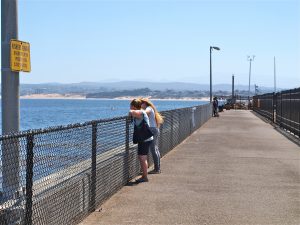
Look, there’s a sea lion on that rock!
The reason is the large colony of sea lions (as many as 1,500 some years) that inhabit the jetty also known as the Coast Guard Pier. There are just a few too many of the cagey animals and their sleep habits are just a little too erratic. The cute and cuddly (not!) pinnipeds primarily lounge on the outer half of the jetty (where Homo sapiens are restricted) but the ill-mannered beasts consider all of the local waters their realm.
They’re kind of like that bad neighbor down the street whose fourteen kids are coming and going all hours of the day and night, and who usually do so accompanied by the screeching of tires and/or the sounds of their motor bikes. And of course don’t forget the weird looking dudes and dudettes who accompany them (where’d they come from?).
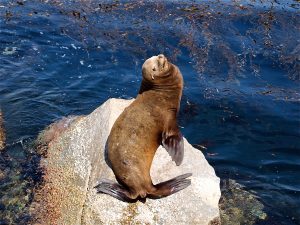
Sea lion aka sea dog
Think your neighbors are noisy? Try living next to a family of 1,500 sea lions! There’s a reason why they’re called sea dogs and their “barking” at times can seem endless (although one report on the pier said that the “gulls call, seals bark, and sea lions bellow”). I heard a little girl ask her mother one day, “why do the seals fart all the time?” Her mother replied, “honey, they’re sea lions and they aren’t farting, they are barking.”
Some people are thrilled and excited by their antics; those who have been around them for a while may have a slightly different opinion. For some, especially those anglers who have had the pleasure of loosing a freshly hooked fish to a sea lion, there can be a real dislike both for the animals (they’re just fur bags in the parlance of these haters) and the government that seems to give them special protection. Such is life today in the new and improved century.
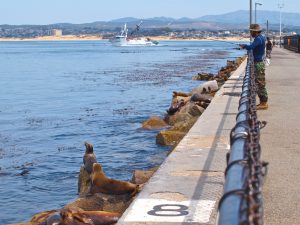
Anglers share their space with the sea lions
Environment. The name “Coast Guard Pier” is actually somewhat of a misnomer since the “pier” is basically a concrete walkway/roadway built over a jetty/breakwater; it also has a cement wall that is approximately 30-inches high. Until a few years ago anglers could fish from that concrete wall. It made it easier to spot the holes and crevices in the rocks and allowed an angler to actually get down to the water if he or she had hooked a large fish. Then they installed a fence which took away a place to sit as well as the aforementioned advantages. For maximum success today it’s important to copy a couple of the local tricks.
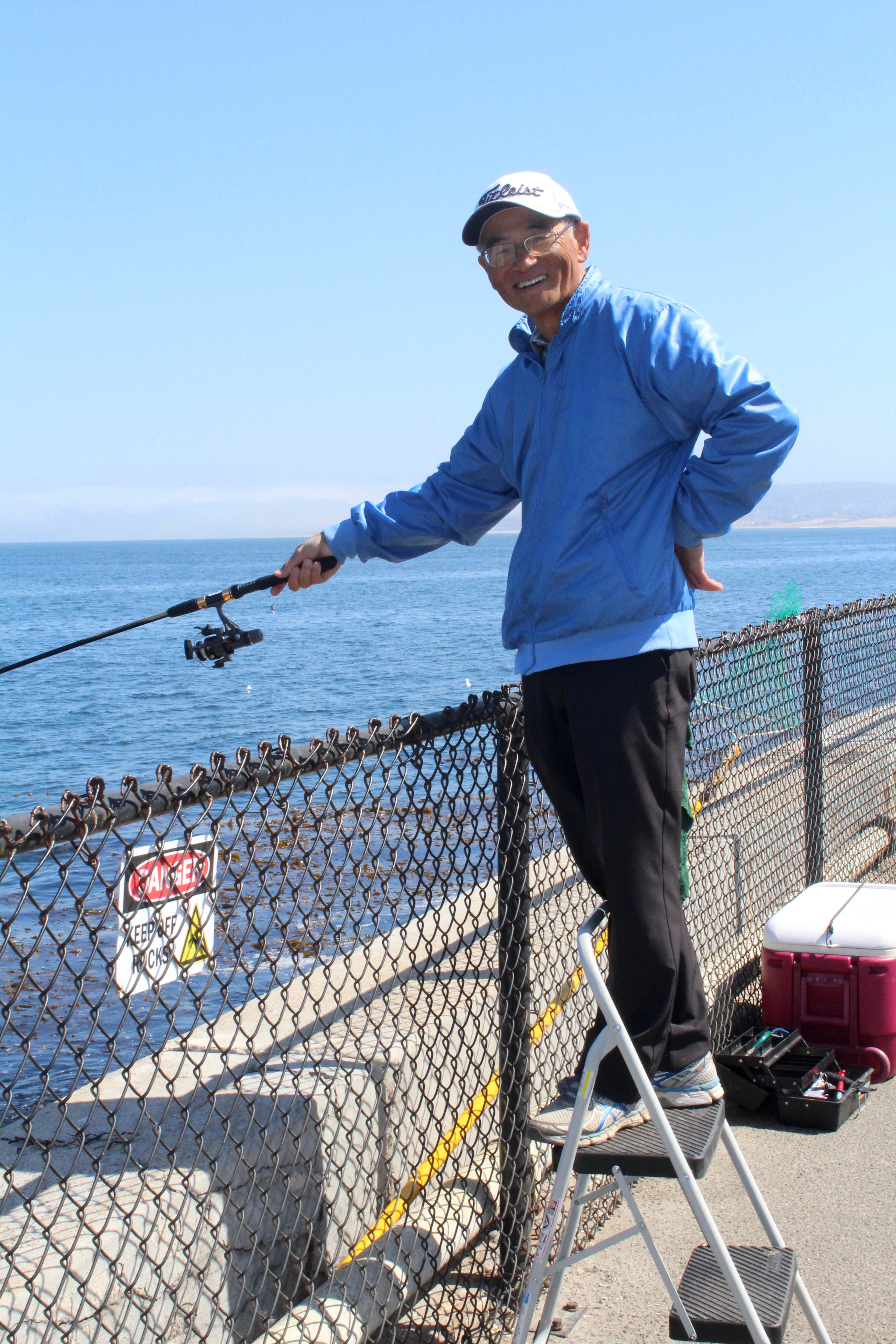
Ted Harada, a regular at the pier, brings a kitchen ladder (that provides a better view) and a long-handled net that he MacGyvered to reach down to the water — and it works.
Sea lions, sea otters, anglers, divers, and kayakers use one side of the jetty, while Coast Guard boats are tethered to the inshore side. As such, an angler is not confronted with the normal attributes of a pier, i.e., pilings with mussels and water around and under the pier. However, the jetty and its rocky environment often produces fish for anglers when Wharf #2 is dead; it also can produce an interesting variety and sometimes quality of fish rare to its nearby cousin pier.
At the shore end of the jetty is the small San Carlos Beach. The jetty extends out from that beach and adjacent to the walkway onto the jetty is a large parking lot. Although the beach is primarily used by divers heading out into the bay, it is also where local angler Matthew Michie caught a 1 lb. 8 oz. blackperch that was, for a while, the state record. That record is now held by a 2 lbs. 9 oz. fish caught in nearby Pacific Grove.
The water itself, Breakwater Cove, is generally fairly calm and shallow although the bottom slopes rapidly away from the shoreline. Water depth is estimated to be 30-40 deep within 40 yards of the beach. The sandy bottom that sits out from the rocks is covered with sand dollars, sea pens, tube-dwelling anemones, nudibranch, and a few sandy shore fish—primarily flatfish and rays. To the west is a kelp-covered reef.
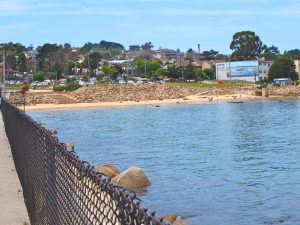
San Carlos Beach
The jetty/breakwater itself is largely made up of large rocks and the water around the rocks, and the crevices and cracks in those rocks, are populated with fish and invertebrates. Low tide will reveal sea stars in a multitude of colors, barnacles, a few sponges, and many, many crabs of assorted size. Mostly unseen are the creatures that cover the rocks underwater—green anemones, strawberry anemones, nudibranch of many colors (including the large rainbow nudibranch), and other creatures of fish attracting and fish attacking ability. Among the critters are quite a few octopi although the nocturnal hours, when anglers are absent, are when they like to come out and play.
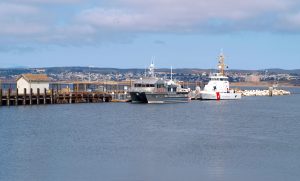
The backside or inner harbor side of the Coast Guard Pier
Oh, and did I mention that there are a few sea lions on the jetty? Most will be on that restricted outer portion of the jetty but there always seem to be a few loitering on the rocks next to where people are fishing; perhaps they want a slightly less noisy environment or are offended by the stench that also exists out at the end? Often there will be a mom with small pups crowded on a rock, sometimes there’s a huge grandpa sea lion taking a whole rock for himself. All will be “Kodak moments” as tourists with cameras are able to get up close and personal with the seemingly docile pinnipeds. The sea lions are joined by a variety of other tenants including harbor seals and a variety of birds (herring gulls, pelicans, and Brandt’s cormorants among others). Also very common are sea otters; rare is the day when you don’t see at least a few of the little guys and gals floating around on top of the water.
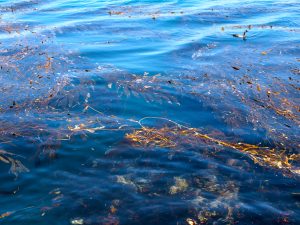
Usually Giant kelp, Macrocystis pyrifera, is found just out from the rocks with the amount varying depending upon time of year and storm activity. Often you can find holes that are clear of kelp between the rocks and kelp, while during outgoing tides you may have a narrow channel of water between the rocks and fronds of kelp. With an inflowing tide the kelp may extend almost into the rocks. During storms and heavy seas fishing can be almost impossible.
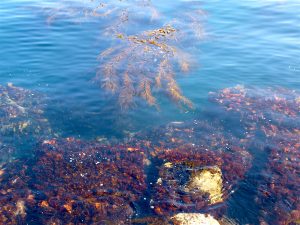
The main impediment/nuisance/irritation to anglers (not counting the sea lions) are divers and kayakers. Most divers enter the water from the beach and many then proceed to swim parallel to the jetty on their way out to deeper water. There can, at times, be conflicts and some divers can be bothersome, rude and unfriendly. The divers, for the most part, are just worried about being hooked (the average is one diver hooked every 19 days) and that might tend to make some people a little nervous and irritable. I’m sure the divers would say anglers are the main impediment/nuisance/irritation. There does not seem to be an easy solution since both groups want to use the area for recreation (and some divers tried to have anglers banned from the jetty when marine protected areas were established for the Central Coast in 2007). Just be careful if you see a diver near your line.
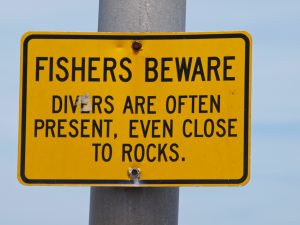
One of the PFIC regulars offered up his advice on avoiding the divers: “la mosca” said to simply avoid morning hours and the weekends. It’s not a bad suggestion since the late afternoon hours seems to see the fewest number of divers and dusk can often be the best time to fish the jetty. (I say this cautiously because I’ve also been told that some divers like to dive the jetty area at night where they can be spotted underwater by their use of glow sticks. Given that anglers only have access to the pier until sundown, the diver’s nocturnal excursions should not be a problem,)
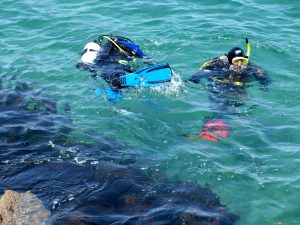
Divers aka knuckleheads who should know better!
The kayakers on the other hand are generally vacationing neophytes out in a rental kayak for the first time. Some of them seem to have no clue as they paddle into the kelp close to shore and sometimes right over the lines of shore-bound anglers. More seasoned kayakers typically swing out away from the rocks. An exception is kayak groups being guided by a “wildlife expert.” Often a group of kayakers, six to twelve, will nuzzle in right at the edge of the kelp so that the “expert” can point out the sea lions, otters and other creatures. Sometimes these “leaders” also seem to have no clue.
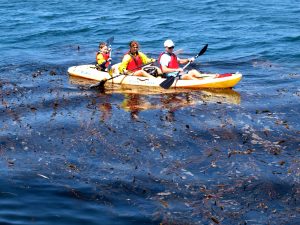
Uh buddy, you’re a little close, watch out for the fishing lines…
Basically an angler is fishing from a jetty environment without the usual dangers of a jetty (climbing over rocks that are sometimes slippery and trying to figure out where to put tackle box, cooler, back pack etc.). Here you walk out on the smooth concrete walkway and have ample and safe areas for all your gear. The ease and convenience of the pier is probably a main reason for it popularity and heavy use (just wish there were a few benches but there really isn’t enough room).
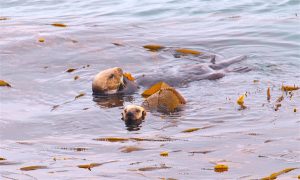
Sea otters are frequent companions
As for the fish, an angler can expect to encounter almost any rock frequenting species that inhabits the Central Coast as well as a few more southerly species. Of course perch and rockfish will dominate the catch. Perch will include blackperch, rubberlip seaperch, rainbow seaperch, striped seaperch, pileperch, kelp perch, sharpnose seaperch (some summers), and an occasional walleye surfperch and shinerperch.
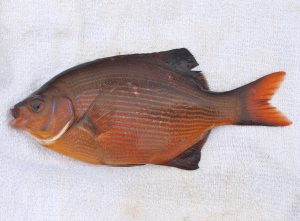
Striped Seaperch
Perch-like species reported from the area include opaleye (including some good-sized fish), blacksmith, and halfmoon (a big run of the “Catalina blue perch” took place in the winter of 2016), along with a couple of wrasse species—sheephead and senorita— occasionally entering into the mix.
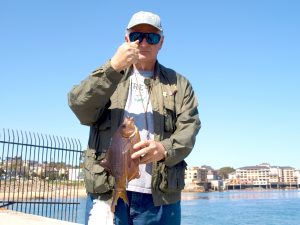
My long-time fishing buddy Mike Granat and a Striped Seaperch
One species so far avoiding capture is the Japanese barred knifejaw (Oplegnathus fasciatus), several of which have reportedly been seen at the jetty starting in 2016. Several of the fish have been landed in Oregon and speculation is that the fish might have drifted over with the debris from Japan’s Great Sendai Earthquake and tsunami that occurred in 2011.
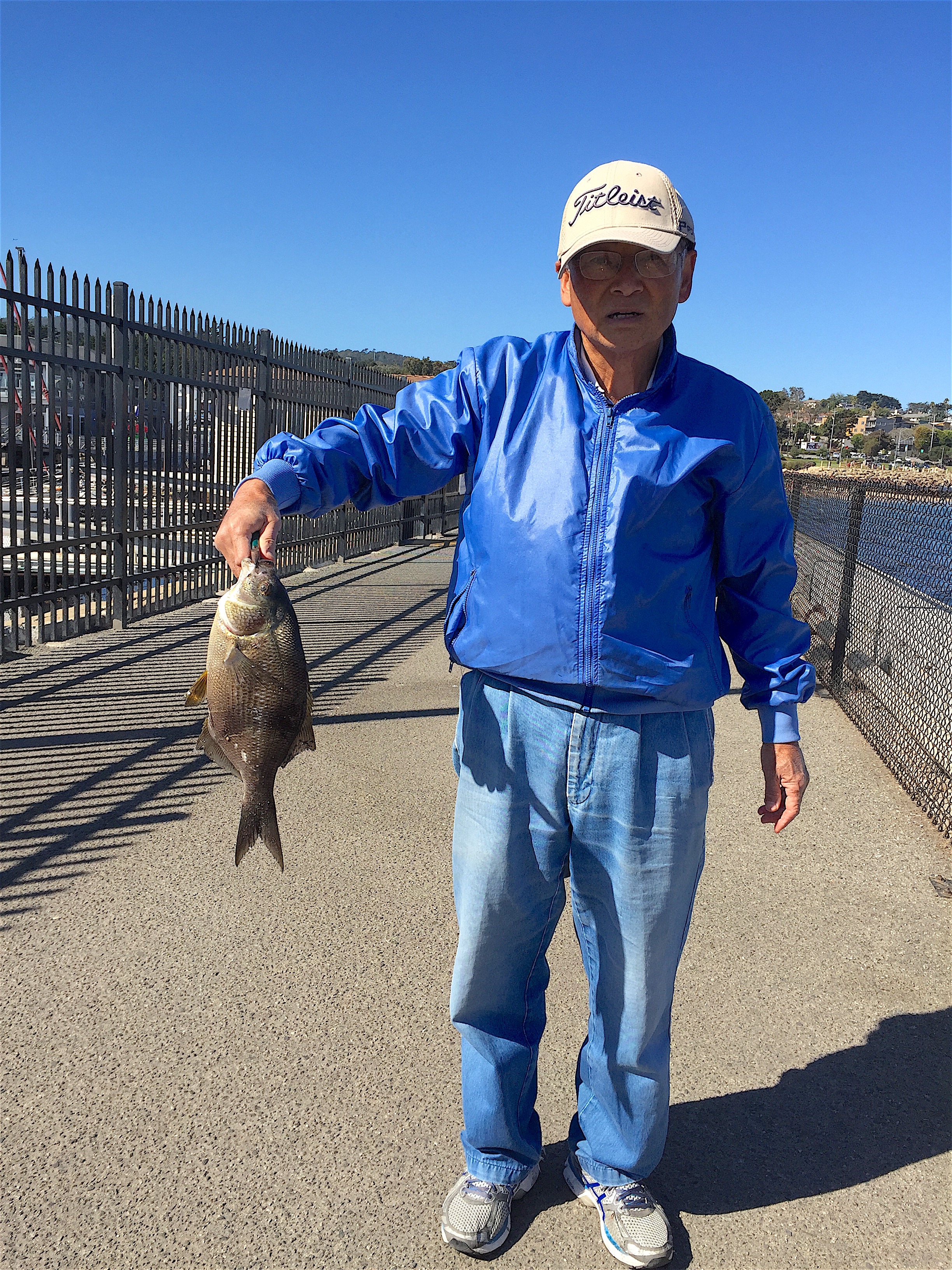
Ted Harada with a nice-sized pileperch
Most of the rockfish will be blue rockfish, black rockfish, kelp rockfish, grass rockfish, black-and-yellow rockfish, gopher rockfish, brown rockfish, yellowtail rockfish and small bocaccio. Related species include cabezon, lingcod, kelp greenling, rock greenling, and surprisingly an occasional SoCal kelp bass (calico bass); a 5-pound calico was taken in 2008. A few small sculpins (various types) will join the fun while a cast from the pier out into the sand might yield a flatfish.
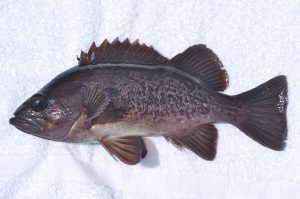
Blue Rockfish
One fish difficult to hook, but plentiful here, is the colorful little painted greenling (aka the convict fish because of its 5-7 dark red or brown bars). I have caught the small greenling on two-thirds of my trips to the pier and average nearly 2.5 fish per trip, far more than from anywhere else in the state.
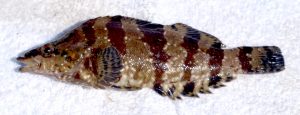
Color variations of painted greenling
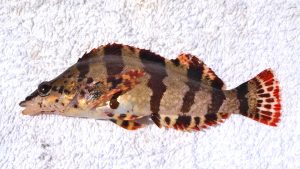
A commonly reported fish is the monkeyface-eel (prickleback) while a few smaller pricklebacks species and larger wolf eels are also found down amongst the rocks of the jetty.
Crabs are found both around the rocks and out in the sand but it’s impossible to use a hoop net and most of the larger crabs let go of bait on a line before it reaches the pier. An unusual crustacean for the area was a spiny lobster taken in June 2009.
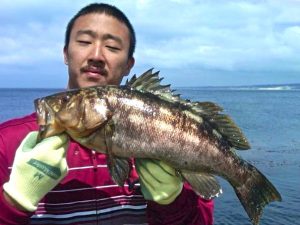
A Kelp Bass caught by “MBay” — they’re uncommon this far north
Fishing Tips. Anglers are basically presented three areas to fish. One approach is to fish straight down among the rocks checking out every crevice and observable hole that might extend back under a rock. This approach is fairly simple but is much easier during high water and when there is not too much surge. The rocks yield rocky shore species although most of the fish under and around the rocks are small to medium size fish (with the exception of some big eels). Smallish rockfish, perch, greenlings and sculpin predominate in this area and there are times when you can even see the fish going after your bait.
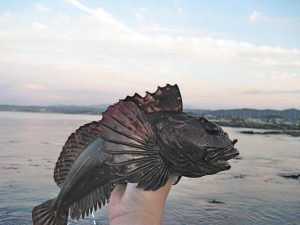
Cabezon
If you fish the rocks you need to be active, you must be holding your rod at all times and you should move along the fence, from rock to rock, hole to hole, until you find a fish. If you’ve dropped your bait down into a hole and haven’t had a bite in 30-60 seconds move on to another hole. If you have a bite, drop your bait right back down into the same hole. If the bites stop, move to another hole for fifteen minutes then return to the hole. If you catch a fish in a hole, drop another bait into the same hole. Favorable spots will often contain several fish, in fact sometimes the fish are stacked like cordwood depending upon the nature of the hole and the rock.
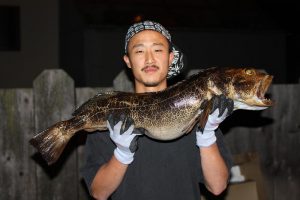
Lingcod caught from the Coast Guard Pier by “MBay”
Fishing down in the rocks is also the best way to avoid the hassle with the divers who, if present, may be swimming out in the kelp. It’s easy to get upset with the divers but they also need room for their sport and it’s no fun constantly wondering if you’re going to hook a wet-suited diver or jawboning over who has the right of way. Better sometimes is to just concentrate your attention and line around the rocks.
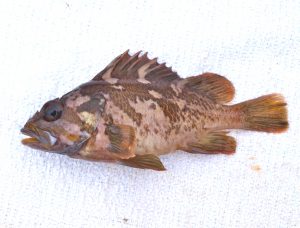
Gopher Rockfish
If you do fish the rocks always be ready for an immediate response if you get a bite. Fish will often bite and immediately head back under the rock where your sinker can become lodged. Tendrils of kelp also occupy these holes and they too can entangle your hook and sinker. You will need to be able to distinguish the difference between the tug of kelp, the grab of a crab, and an actual bite of a fish. Until you do, you will lose some sinkers; after you learn the difference you will just lose less sinkers.
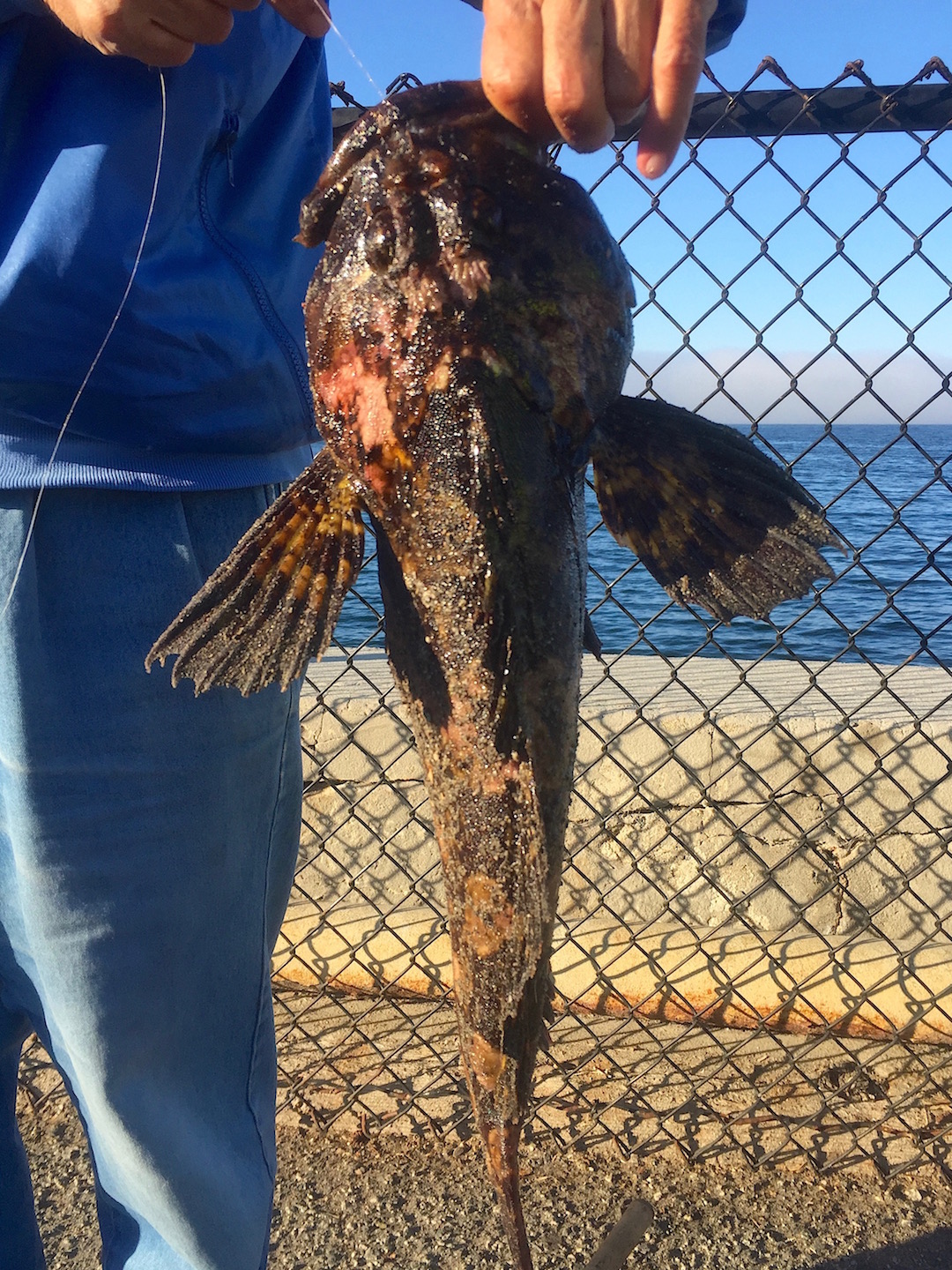
A good-sized cabezon caught by Ted Harada
Also use a stout pole and fairly heavy line (at least 15-pound test). You must be able to crank your fish quickly out of the hole and, at times, be able to break through the kelp you hook. One recommendation—use a single hook and use a sinker that is less likely to lodge in the kelp or a rock (i.e., a torpedo sinker). You might also want to attach your sinker at the end of your line with a short, lighter-than-the-main-line leader. You will lose some sinkers but if played right you should be able to save some fish.
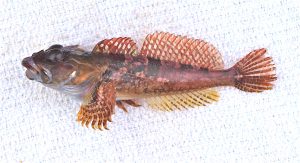
Coralline Sculpin
The second approach is to cast between the rocks and the kelp. Local expert Sin_Coast suggests that most of those who fish straight down primarily get small rockfish while this area yields bigger fish. He says the trick is to cast only 20-30 feet aiming for the inside of the kelp near where the jetty rocks end. However, the water area can vary, as said, depending upon the time of the year and the growth of the kelp. Tidal surge can also play a role since you are fishing right next to, if not in, the kelp. Sometimes you can spot water that is relatively clear, sometimes you can’t. Again stick with one hook and a sinker with a thin outline—a torpedo or even pencil sinker.
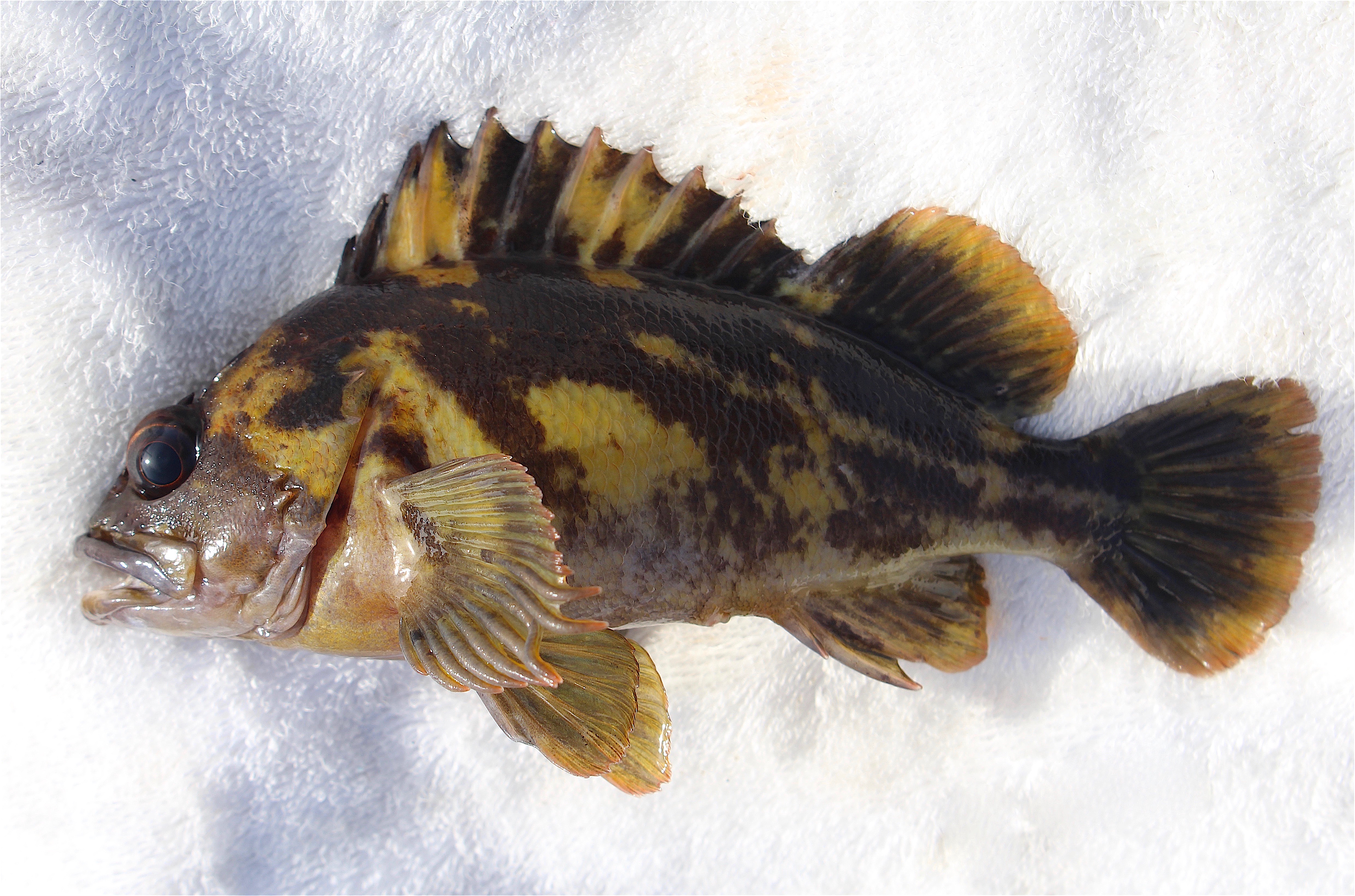
Black and Yellow Rockfish
The third approach is a cast over the kelp into the deeper water. Some anglers seem to prefer this approach but I’ve always felt that casting out into the sandy areas yields less fish; more species like to be found around the kelp and rocks. Of course the danger you are faced here is retrieving your rig up and over the kelp. I don’t think it matters as much if you have one or two hooks but a flat sinker is often the best type of sinker. And, on the retrieve, pull the line in quickly as well as when a wave is incoming; there is less chance of tangling with the kelp.
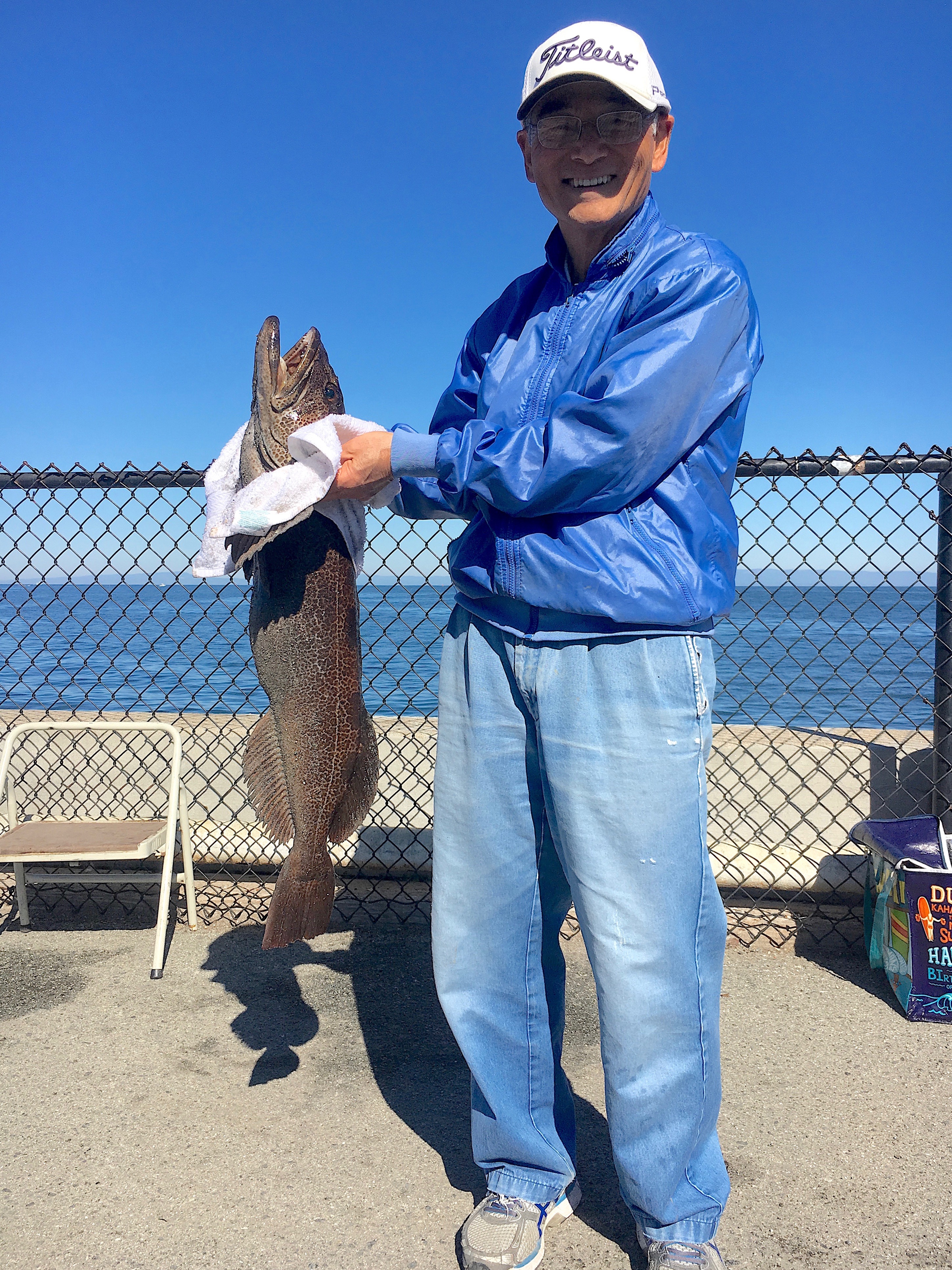
Lingcod by Ted Harada
Different fish can of course respond to different baits and techniques. As for the perch, I generally recommend a fairly light line, small size 8-4 hooks, a one-ounce torpedo sinker, and bait such as pile worms, bloodworms, ghost shrimp, small pieces of market shrimp, or fresh mussels. Here it’s hard to use light line but you can use fluorocarbon line to compensate for the size of the line.
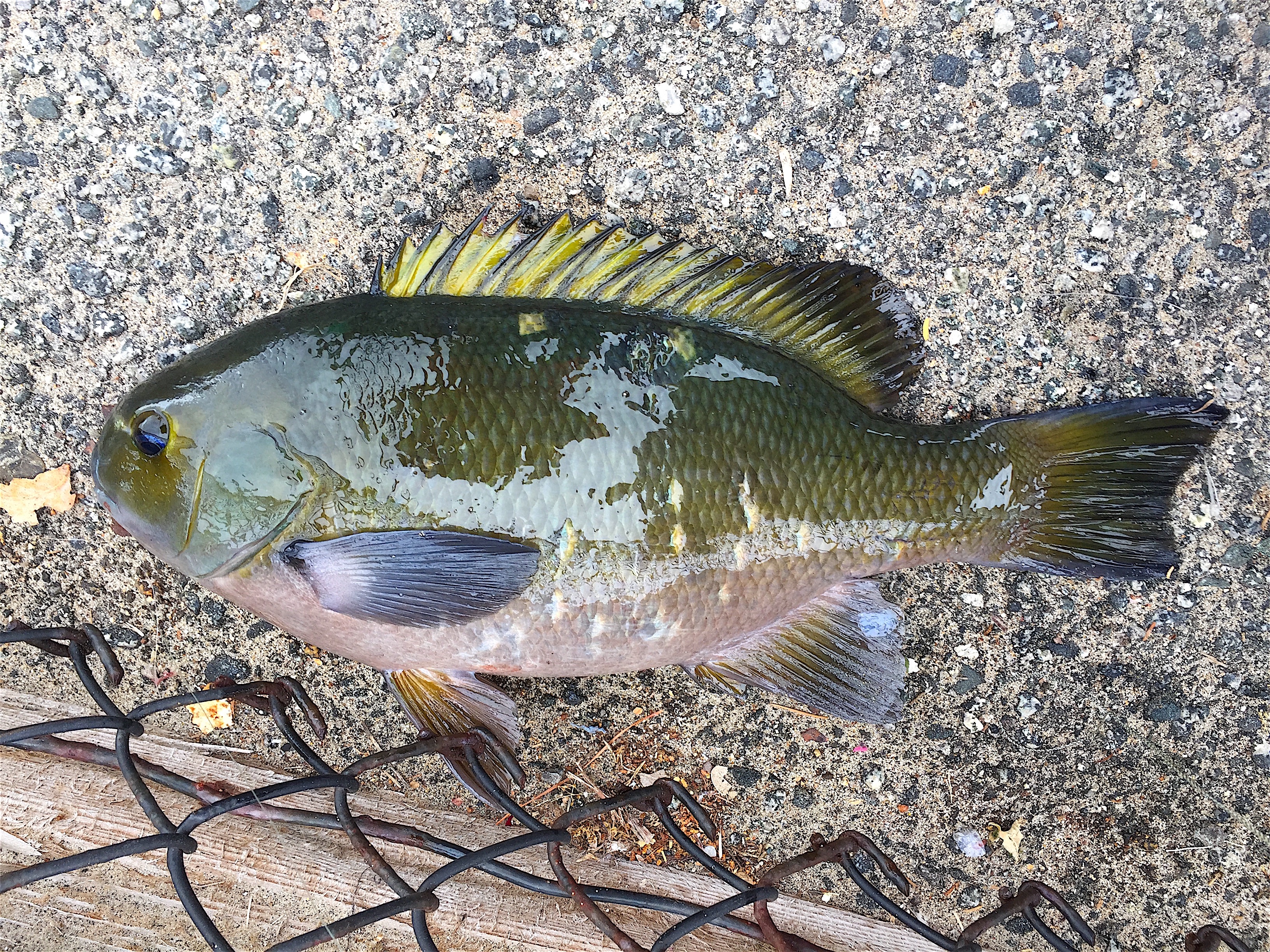
An opaleye caught by Ted Harada
If you see opaleye crusin’ the rocks try ghost shrimp, seaworms or frozen peas and small hooks. Remember that springtime is often the prime time for the perch.
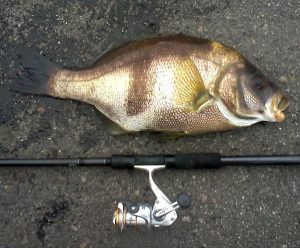
Rubberlip Seaperch
Rockfish have bigger mouths and take bigger hooks but often like the same baits. However, you can also catch them on cut anchovies and squid. Lingcod love live bait (a small perch) if you can get it while cabezon really like small crabs and ghost shrimp (but they’ll also take the squid). Summer to fall is often the best time for the rockfish and cabs, while fall is always a special time for the lings. But don’t ever be afraid to toss on a live bait and try for a lingcod; there are usually a few fish around throughout the year.
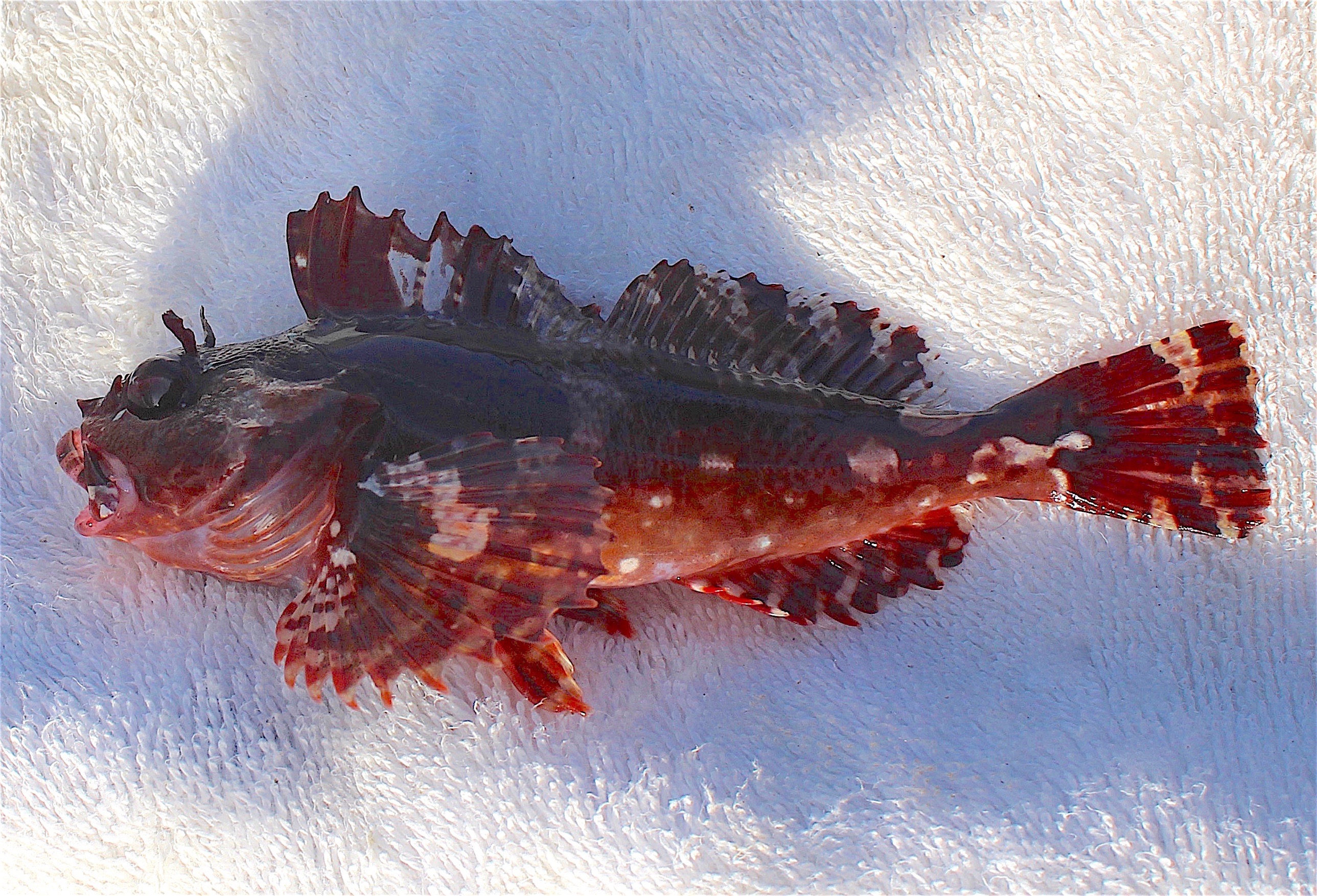
A colorful young cabezon
Artificial lures can also work but watch the kelp and the surge. Plastic lures like Big Hammer and Fish Traps will work as well as grubs and Berkeley Gulp; I have heard of little success from people using the Berkeley crabs or shrimp. Size of the lures should be set to match the fish and some of the locals use worms up to 10” in length to pull in the bigger fish (and they feel it keeps the smaller fish off the hook).
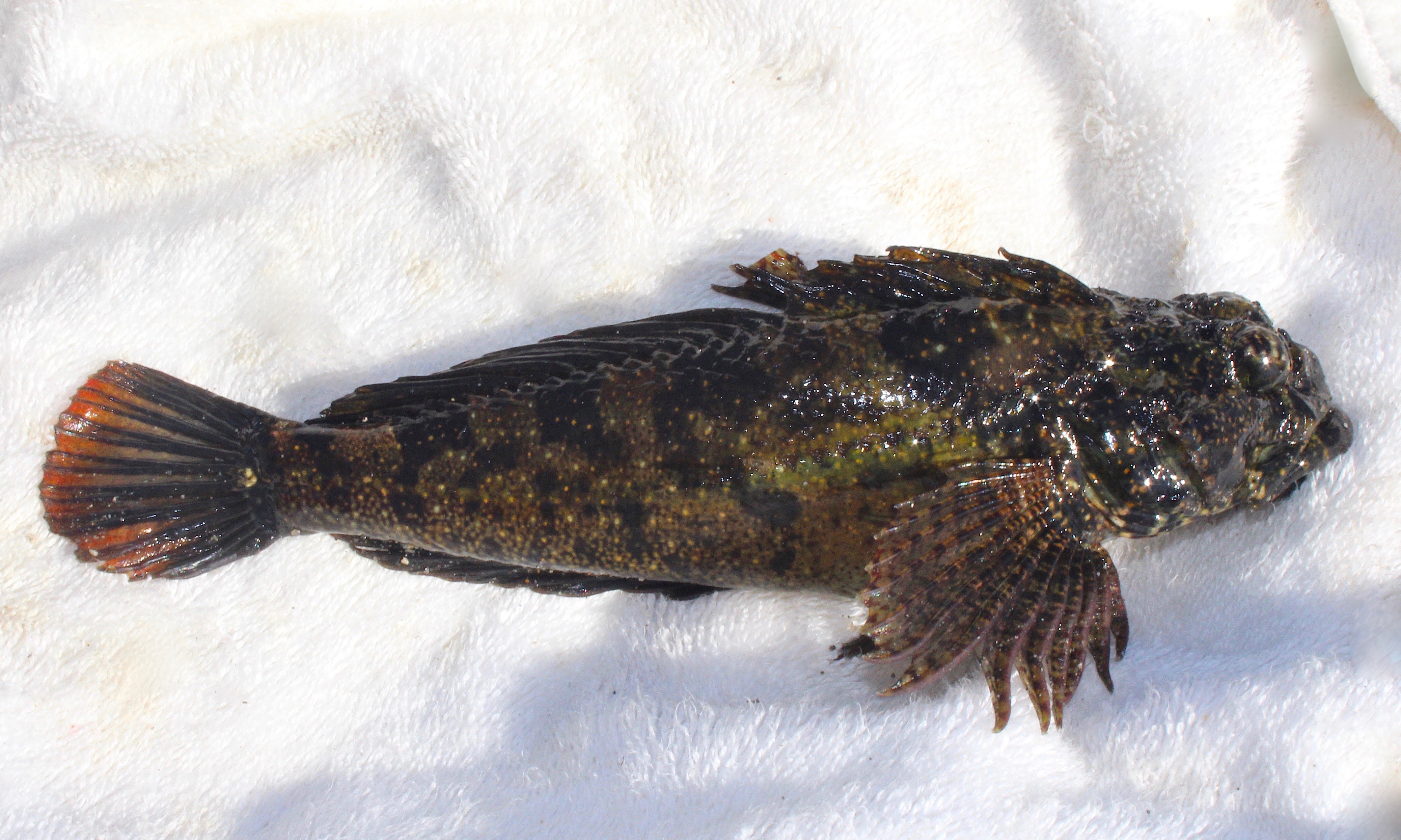
Snubnose Sculpin
If specifically seeking out the big monkeyface-eels come equipped with some medium-sized gear since they can be a chore to get out of their lair if you allow them to escape the initial strike. Also come prepared with a net to bring them up onto the deck.
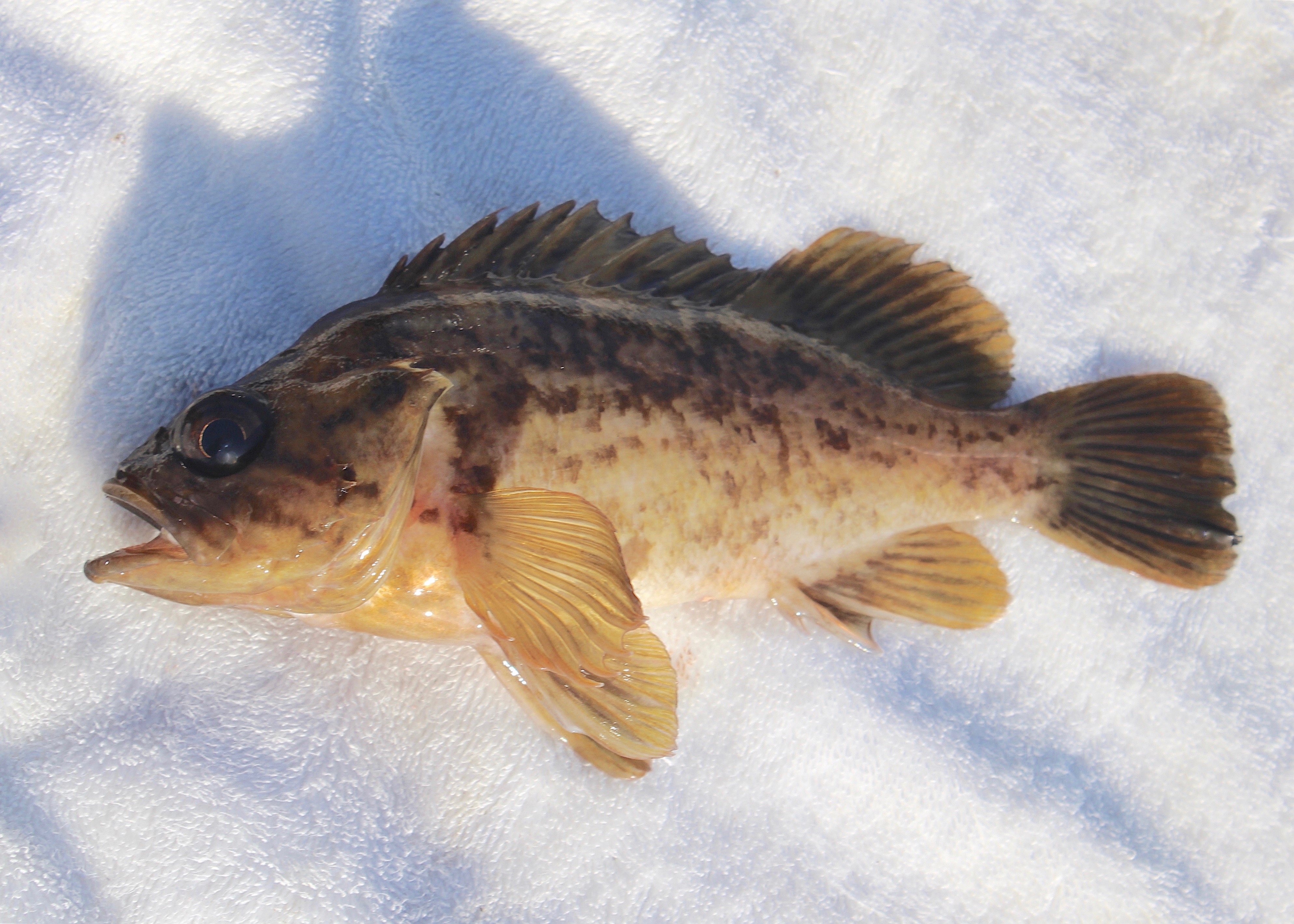
Kelp Rockfish
The Pier Rats Speak
Date: April 14, 2001; To: Pier Fishing In California Message Board; From: avid angler; Subject: Monterey Pier Report
The Coast Guard Pier is producing striped perch to 1 1/2 pounds and my buddy caught a small sheephead. There are always rockfish and lingcod around and as soon as the season reopens it should be fantastic for those in the know. Live anything for the lings. I have my preferential baits. Try shiner perch. Incidentally the striped perch are LOADED. Use shrimp.-AA
Date: May 1, 2001; To: PFIC Message Board; From: Ken Jones; Subject: Monterey Piers
Got a report from our new reporter Avidangler who said, “The Coast Guard Pier has been yielding some great catches of black and rainbow seaperch to two pounds. Mussels are the hot bait for these perch. Shrimp can also be very effective. Lots of rockfish, cabezon, and some lingcod have been showing up in catches. Today we had a five pound or so ling chasing our perch from under a rock after we hooked them.”
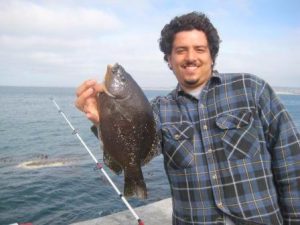
A good-sized Blackperch from the pier
Date: June 10, 2001; To: PFIC Message Board; From: aarondaar; Subject: Lobster in Monterey?
A friend of mine told me that sometime last summer (or two), there were a large number of lobsters(?) that came up on the beach (alive). She didn’t see it in person, but saw it in the news. Anyone know what she’s referring to? Inquiring and hungry minds want to know… aaron
Posted by Ken Jones
I haven’t heard of any in Monterey but know that some Eastern lobsters were released in the Santa Barbara area and off of San Francisco. For a few years I heard of occasional catches in both areas; haven’t heard anything recently. Unless it was warm water conditions I don’t think California spiny lobsters would survive. However, during the El Nino years it’s possible a few headed north.
Posted by avidangleron
I saw one landed off the Coast Guard Pier last year, and a fat one at that. Not sure what brand though. I offered to buy some butter and boil some water but the guy thought I was joking with him. I do remember that it had no claws? – avidangler
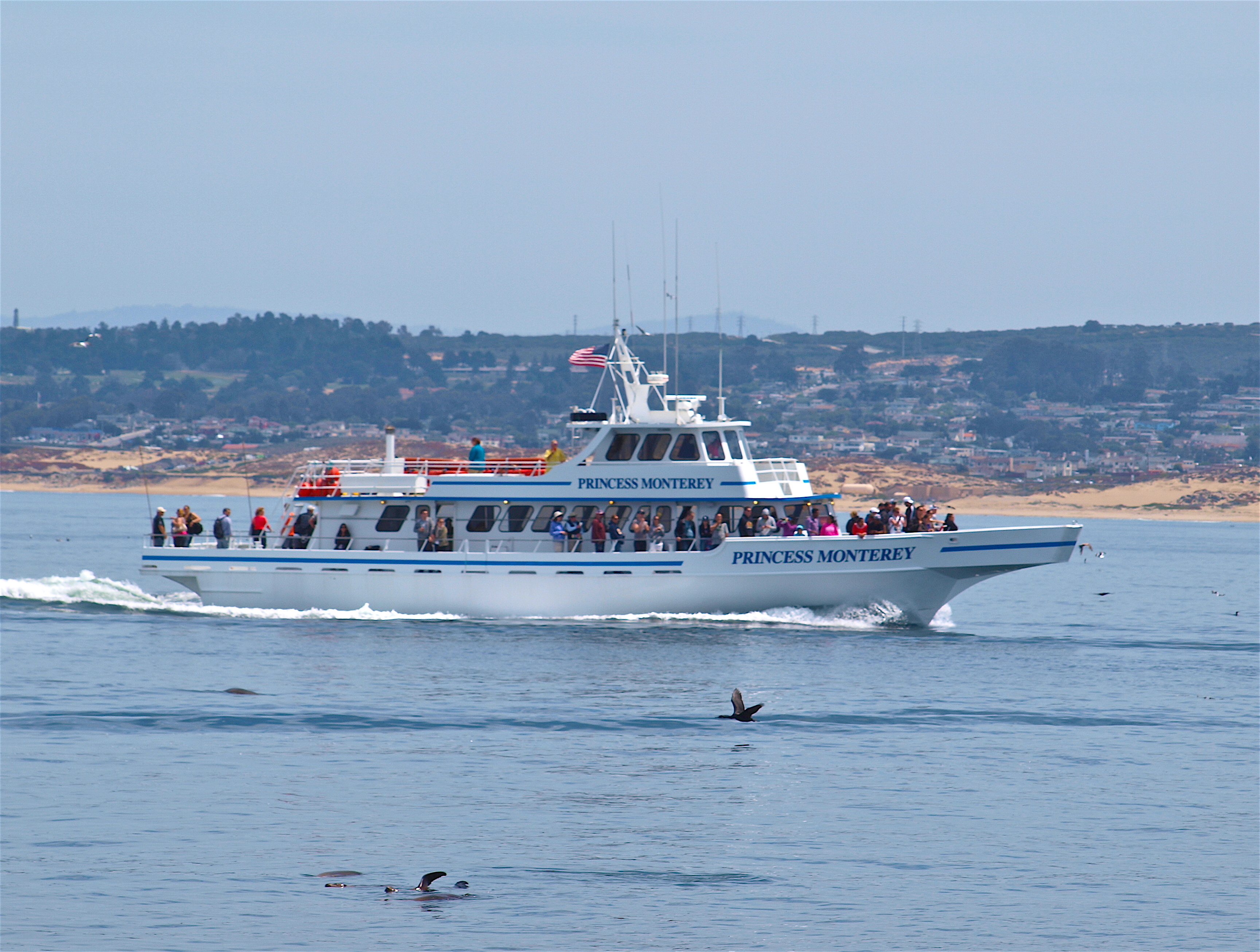
Whale watching boat?
Date: May 26, 2002; To: PFIC Message Board; From: avid angler; Subject: Monterey Coast Guard Pier
I just got back from three hours of non-stop rockfish catching. Fish are loaded at the jetty. Species included were yellowtail, blue, and kelp rockfish, a few bocaccio, and one calico bass. All caught on three-inch pumkinseed grubs. All fish were released-AA
Date: September 24, 2003; To: PFIC Message Board; From: alfred; Subject: Monterey Bay Fishing report
Tuesday 9-23: Monterey Coast Guard pier: two hours with peas, cooked shrimp, and moss yielded one blackperch (released). My intended target were opaleye, but nothing I tried worked (bobber, bottom rig, etc.). There were some HUGE opaleye swimming in the clear water–any suggestions on catching them would be much appreciated. There was one other angler targeting rockfish with plastics, but he had no luck either.
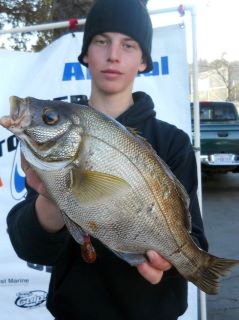
Large rubberlip seaperch caught by Minnow Magnet
Date: June 15, 2005; To: PFIC Message Board; From: pinoy; Subject Re: Tsunami warning at Port Harford … posted by pierhead
We received the same warning at the Coast Guard Jetty here in Monterey. One of the CG guys came running down the pier advising everyone to leave immediately, while the rest of his buddies were running to their boats to go warn the numerous fishing boats on the bay.
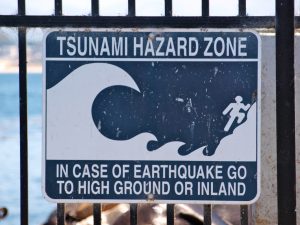
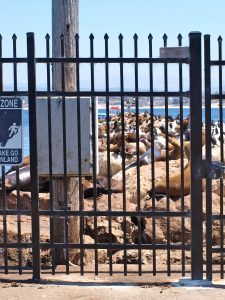
Who will warn the sea lions on the jetty?
Date: July 22, 2005; To: PFIC Message Board; From: pinoy; Subject: MB huge eel!
As usual, my wife and I went for a bit of fishing after I got home from work. The Monterey Coast Guard jetty was not crowded, and the water is so calm. Within 15 minutes of setting up, my wife started yelling for help. She’s got something big that she can’t reel out of the hole between two rocks. I was skeptical, but when she handed me the rod it jerked pretty hard. I tested by releasing a few inch of line, and sure enough it kept pulling deeper. Finally, I released about a foot of line and timed my reeling when the line starts to get pulled. We were amazed to see that there’s a huge eel on the end. It took both our efforts to get the eel out of the water and over the cement wall. I was reeling as much as I can while my wife is also pulling the line hand-over-hand. I didn’t catch anything at all. Oh well! It seems my wife is outfishing me already nowadays. Here’s the picture of the 4-lbs 25” long Monkey-Faced eel.
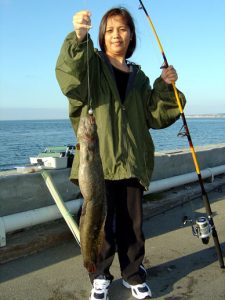
Monkeyface Eel (actually a prickleback not an eel)
Posted by pinoy
I live around the area, and we often go fishing around 6pm. To make sure I don’t get another parking ticket, I still drop a few coins to the meter so that it’s valid up to 7pm… Most people catch rockfish around 8” or smaller. But my wife and I have been going there a while and memorized many holes and hiding places. We often go home with a couple of 11-12” rf after usually losing 2 hook and sinker each. There’s also the occasional eel and perch. I’ve also caught a legal lingcod from the end of the jetty. This other regular fisherman at the jetty has caught about 4 lings already since I started going there. They’re around the 26”-30+” range. I guess it depends on luck too. He stays there all day sometimes until his arm is sore from casting. We do go home without any catch every so often. The most productive times is at high tide and sunset.
Date: July 28, 2005; To: PFIC Message Board; From: pinoy; Subject: Another Monster Eel!!!
Hi guys! My wife and I did some fishing at 7pm in Monterey CG jetty again yesterday. I finally beat my wife’s record monkey faced eel caught at around 7:30. We fished for another hour after the huge catch. Final tally is…
One MF eel 27” and 5 lbs — Two 8-9” rf (thrown back) — One 12” blue RF (kept for steaming)
Date: August 1, 2005; To: PFIC Message Board; From: pinoy; Subject: Believe it or not! Got another huge eel!!!
Sorry guys, I didn’t post the report earlier. This will be like a summarized weekend report for Monterey Coast Guard jetty. Warning! Its looong!
FRIDAY: My wife and I decided to cap off the day fishing at CG. Usual setup with wife using 8-ft pole and me with 10-ft rigged with #4 hooks, 2-oz sinkers, and squid baits. Within a few feet of where we got the huge eels we posted last week, my wife got another one! She actually felt the hit and reeled as soon as she felt it. There wasn’t much tug of war to get it out of its hole. But I had to run and help her pull the line by hand while it was midway up the concrete barrier because the eel decided to wiggle a lot to try and get free. Tourist had fun taking pics afterwards. There’s this family passing thru, and the parents are divers. To my irritation, they kept repeating that its rare and it should be thrown back. “Rare?” I asked. Because they never see it while they’re diving. I told them it was already the 5th or 6th monkeyfaced eel we got from the area. They had to repeat it three more times before they walked off like we’re insolent stupid kids. But I answered them already that we are keeping it because its good eating and my dear old mother loved eels so much. It’s not like were wasting the eel and just did all the effort just to play with it. Maaan, that really bugs the hell out of me. I don’t think the mf eels are sociable enough to go pose for pics with the divers when they’re down there with their cameras. Anyway, my irritated mood probably contributed to my zero catch that day.
One mf eel 26.5” and 8-lbs — Seven 8-9” rockfish, very reddish color—thrown back
SATURDAY: Not much action except for quiet a few divers who love to go exactly where you’re casting. No consideration. They swim right in front of you and then dive and poke around until you change spot, only for them to follow again in 10 minutes. I wonder if they’re doing it on purpose. If they’re there before we do, we are nice enough to move on to a different spot. Or if they’re passing through we reel our line in if it’s on their way. Can they do the same? Got only one good hit which almost took my pull over the railing. I left the pole to go share a muffin and coke with the wife until tourist passing by yelled “your pole is going over!”
One fat 11” rf (steamed for dinner) — One 4” rock crab (thrown back) — Plenty of bites but nothing landed — One 5” rock crab (thrown back)
Posted by dompfa ben
I don’t know a thing about the MFE fishery up there, but rare or not, that’s a nice catch. Tell the divers they would see more down there if they put the glass part of the mask on the FRONT of their heads. They might also consider taking their heads out of their grasses…eel grass, that is. I’m guessing those big pricklebacks probably spend a lot of time in their holes, and only come out to eat? Which makes the divers’ comments about as valid as assessing an earthworm population in a field by walking across it.
Posted by its a keeper
I don’t know if they live in colonies, but I doubt they do since each one wants their own hole (home). But sometimes they share the same big hole that house mini smaller holes in the main big hole. What I am trying to say is that they might be sharing the same driveway to the open. I hear stories and confirm that upon a big fish coming out of one hole, there are others in there as well. So go back to it and fish it again. There might be a huge cabezon in there perhaps.
Posted by its a keeper
Send in for the California’s record. I ran past this site where this guy said he certified his MFE at 6.1 pounds and he mentions that at the time he caught his fish the state record was 4.8 pounds. So you are well over that weight.
Posted by pinoy
I called the local Monterey DFG office but they don’t have much clue about the Angling Record requirements. I told them I just need one of their biologists to certify it. Waiting for some guy from their Sacramento office to call me back. Do you guys happen to know anybody I can contact? There’s also this thing about a State certified scale. Any ideas? Are these the scales they use at fish markets or local stores like Safeway? This is going to be cool if I can get it on the record! My cheap scale said its 8-lbs. Another regular fisherman at the area previously verified my 5-lbs catch with his digital scale. So I’m assuming it will be close even if my scale is off a bit.
Posted by pinoy
No more worries! Finally got hold of someone at the DFG Central Coast Regional office. She gave me a list of local Monterey DFG biologist and phone numbers. She also verified that any cooperative store that uses weight scale that are inspected and certified by the CA Weight and Measures division (yellow tag attached) can do the weight part of the form.
Posted by pinoy
Sad note! I guess we can’t use a cooked eel for the required verification procedures for the angling record. My fault! I was so excited and researched about all morning, but I forgot to call and tell my wife. I got home and found out we have eel adobo for lunch. Hmmmm yummy!
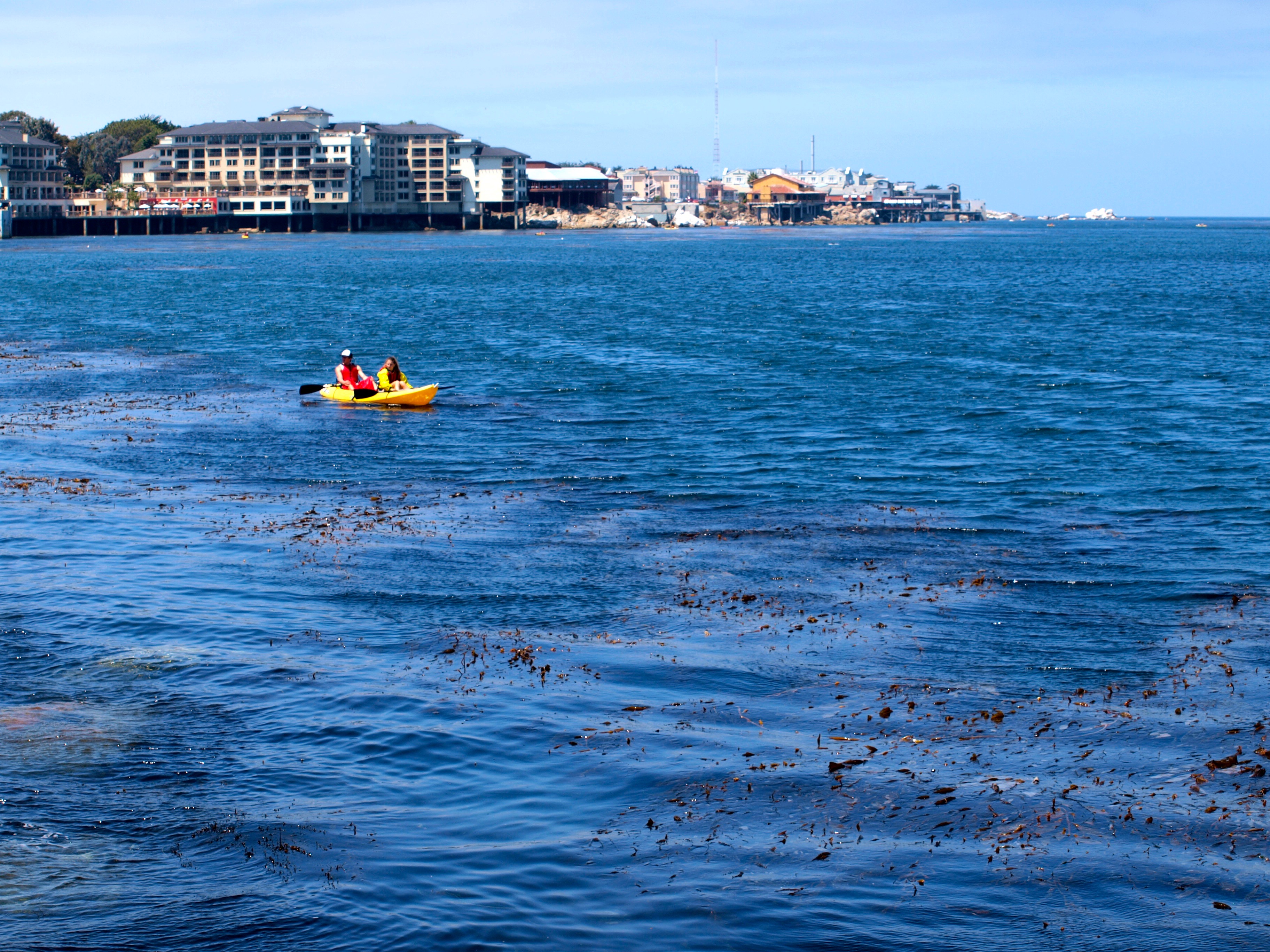
The famous Cannery Row (now mainly the home to chain hotels and restaurants but also the world-class (some say best in the world) Monterey Aquarium
Date: August 4, 2005; To: PFIC Message Board; From: pinoy; Subject: Eel Meister’s lucky streak continues!!!
After a tough day at work, my wife and I hit the usual spot at the Monterey CG jetty around 6:30. Water was still low but calm. Used the usual rig (#4 hook, 2oz sinker) and squid bait. Dropped the bait into what you guys call “eel honey hole”. Left it there for about 5 minutes. It was heavy, but my leader broke after 3 minutes of tug of war. Reset my rig and left the bait in the hole again for another 5 minutes. When I went to check it was heavy, but when I pulled hard it gave a few inches and then stuck. Gave it a foot of line, and tried reeling after 30 seconds. Still not moving. Gave it more line 3 more times, and on the 3rd time I reeled after only about 5 seconds. It was heavy, but it was inching up as I reel hard. Within a minute, there it was another mf. Called the wife to help with the last 2 feet up coz my pole is bent and can’t reel in anymore. It was 25” at 4.4 lbs (2kilos). Afterwards, the rest of the time at the jetty was spent catching and releasing small rf (4”-8”) about 9 total. I played with something on another hole close by, but my leader or line kept breaking since it was directly grinding on the rocks. Didn’t see what that was whose playing with me. After I fixed my rig for the 4th time, there was no more nibble from that hole. Oh well…
I’ve proven that what we were talking about in my previous post is true. That hole I found is a prime spot. Like “pointme2dfish” said, as soon as it’s vacated a new tenant moves in. Hehe! Too bad I couldn’t submit my wife’s huge eel for the angling record. As I said in my previous post, it was already cooked as adobo when I got home for lunch. This latest catch is a bit smaller than the record. Hopefully the streak continues, and we will get one that we can submit for the angling record. Keep on fishing!!!
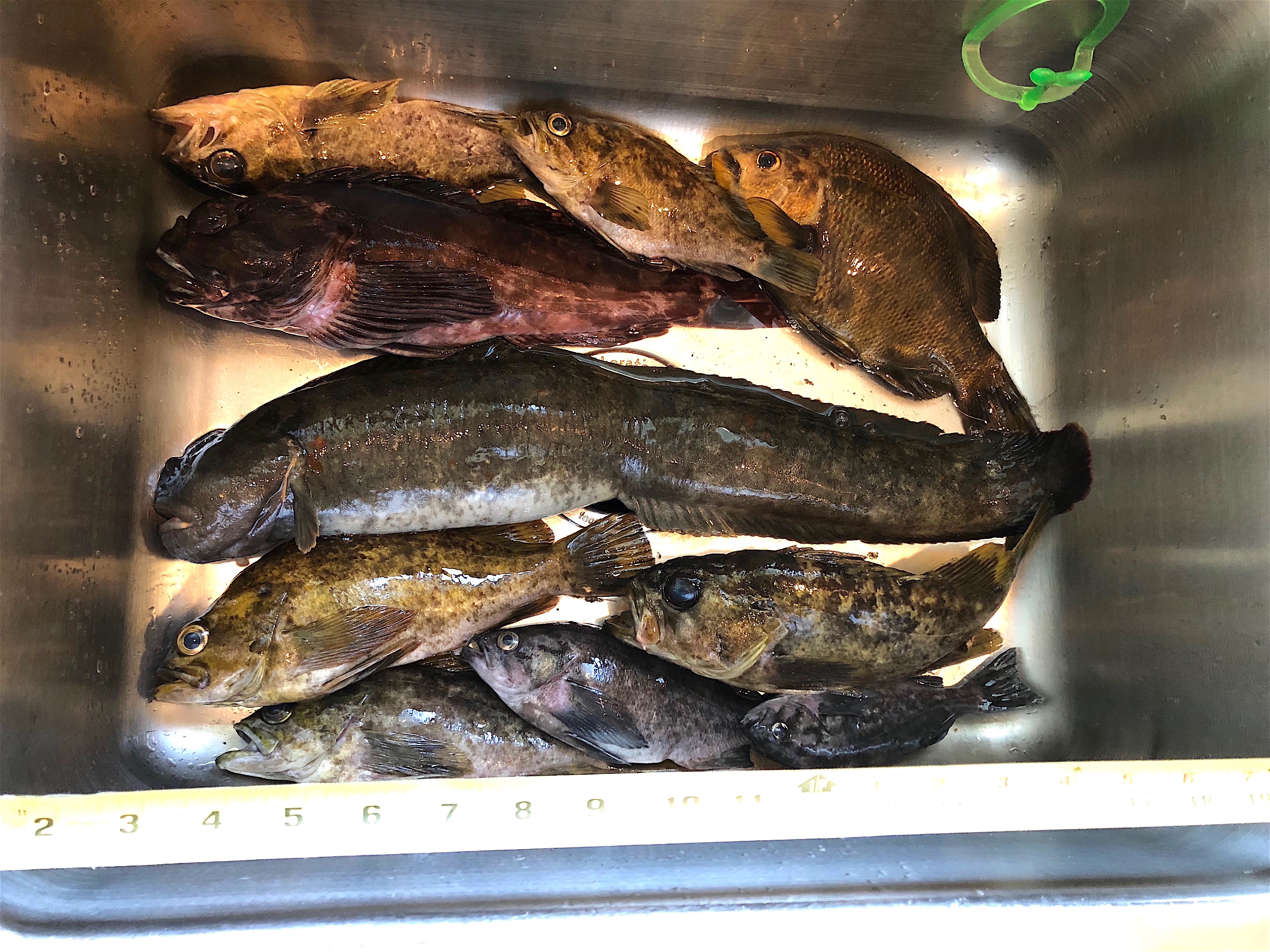
A nice mix of perch, rockfish, cabezon and monkeyface eel by Ted Harada
Date: October 15, 2008; To: PFIC Message Board; From: northern boy; Subject: Crabs at Coast Guard Pier
The Coast Guard Pier/jetty is full of crabs. I would suggest a snare or even just chicken-leg-on-a-string rather than a hoop net tho’. You’re likely to lose the hoop net to a snag or seals and even if you don’t, it’ll be hard to bring a hoop net up onto the jetty without spilling the contents. Snares are legal and very popular. You should be able to find them in any bait and tackle store. They’re only ~5-6 inches across. ‘There is a rule about the # of loops they’re allowed to have, but I forget exactly what it is.
As for the crab taste; if you’re not familiar with local crabs, you’ll catch two types off the rocks here. One has black tipped claws that are very large. Their shell is brownish. The other type has a deep red-color shell and smaller (in proportion to their body), white tipped claws. This second type is generally larger as well.
IMHO the larger red crabs taste the best (better than Dungeness I think). The browns don’t taste as good and there isn’t enough body meat to make them worthwhile.
One final thing; you have to have a rigid measuring device. Just to be safe you might as well pick up a crab gauge when you get snares, they’re only ~5 bucks. Cheap snares and gauges are made by Danielson, I think.
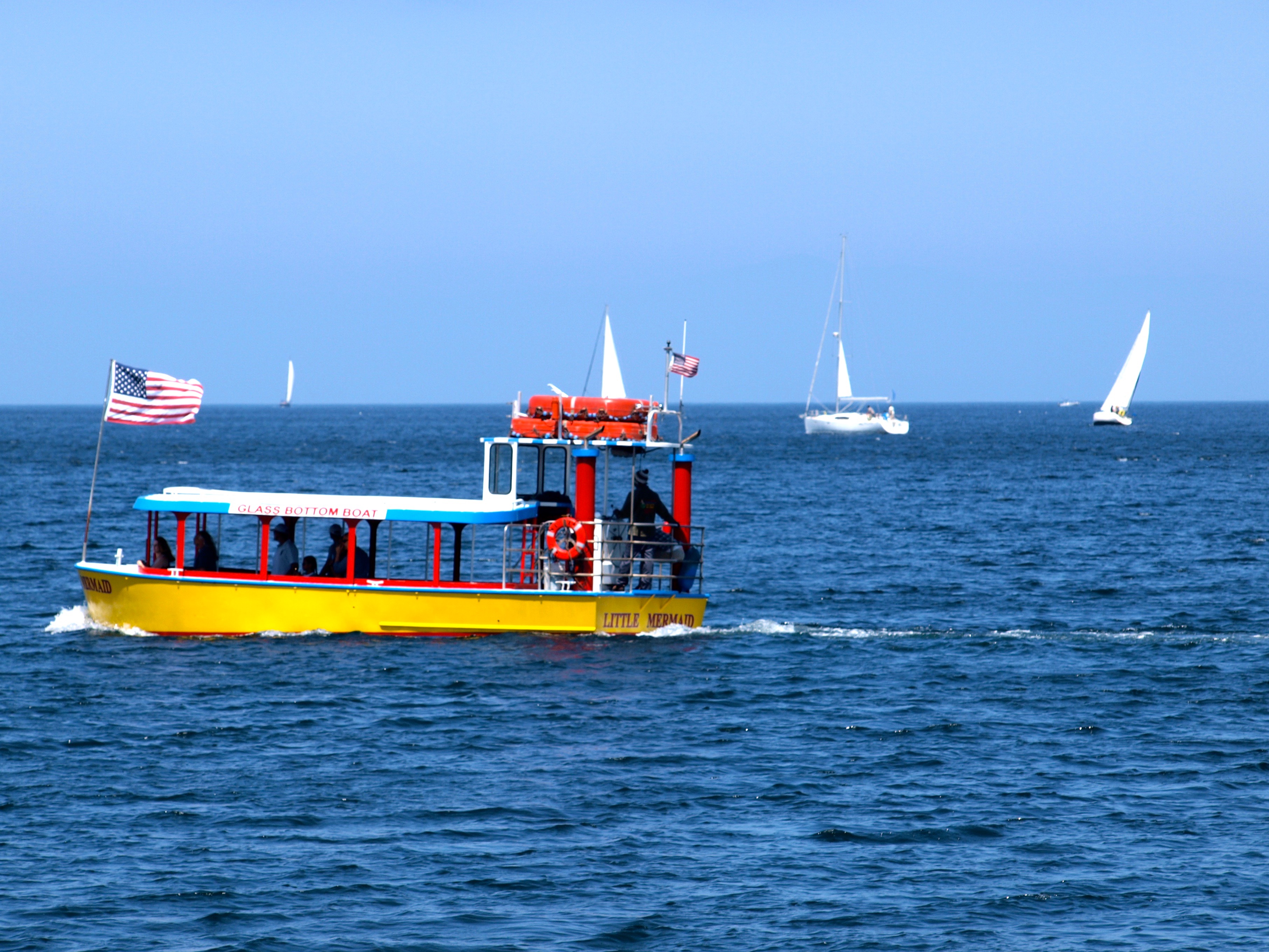
Potpourri — Possibly more than you want to know about the Coast Guard Pier
<*}}}}}}}}}>< — In 2006, when the Central Coast Marine Life Protective Act (MLPA) process was playing itself out, an interesting argument was given by the side that wanted to see the jetty included in a no-fishing, state marine reserve. The gist of the argument was the danger to divers and the diverse assembly of fish found near the jetty. Of course making it a reserve would have also precluded any consumptive use by divers. They might be able to take a picture and harmonize with nature but certainly never would have been able to shoot a fish or remove an invertebrate (and I wonder how many divers actually supported this proposal?). Luckily, the pier was not included in the list of new reserves. What really spiked my interest was the following letter and the number of different species of fish reported at the jetty.
From: John R. Wolfe; Sent: Wednesday, February 22, 2006; To: MLPAComments@resources.ca.gov; Subject: MLPA Comments
Package 2 of the Central Coast Regional Stakeholders Group (CCRSG) recommends that the north side of the Monterey Breakwater (also known as the Monterey Coast Guard Pier) be included in a no-take State Marine Reserve.
Strong reasons for Marine Reserve status include the intense recreational use of this area by SCUBA divers (it’s the most popular dive site on the west coast of North America), and removing the danger to divers being hooked by a small group of pier fishermen (in documented cases between Jan – Sept 2005, a diver was hooked on average every 19 days). Sea lions and harbor seals in the area have also been observed with hooks embedded in various parts of their bodies.
One lesser-known reason for including the Breakwater in a State Marine Reserve is the unusually high fish species biodiversity in this small area. The combination of deeply fissured rocky reef, kelp canopy and adjacent sandy bottom, and the confluence of the northern and southern California fish species, all contribute to this fish species diversity. Volunteer recreational divers for the Reef Environmental Education Foundation (REEF) have conducted over 8,500 surveys of fish species at hundreds of dive sites along the west coast. The greatest species richness reported by REEF along the entire west coast occurs at the Monterey Breakwater (see http://www.reef.org/stats.htm ). Attached is a composite list of 97 fish species observed at the Breakwater by REEF divers, and by Dan Gotshall, retired marine biologist for the California Department of Fish and Game and the author of the book Pacific Coast Inshore Fishes.
The Breakwater has also played a historic role in marine biology. The Masked Prickleback Eel was unknown to science until the 1960s when it was discovered at the Breakwater by David Powell, the former Director of Live Exhibit Development at the Monterey Bay Aquarium. In summary, the Breakwater is a unique marine habitat with tremendous species biodiversity, and deserves Marine Reserve protection.
Respectfully submitted.
Fishes Observed at the Monterey Breakwater and Surrounding Soft Bottoms by Dan Gotshall (DF&G), 1962-2004, and by 246 REEF surveys, 1997-2005:
- Spotted rat fish, Hydrolagus colliei 2.Thornback, Platyrhinoidis triseriata 3. Bat ray, Myliobatis californica 4. Pacific electric ray, Torpedo californica 5. Green sturgeon, Acipenser medirostris 6. California lizardfish, Synodus lucioceps 7. Spotted cusk-eel, Chilara taylori 8. Red brotula, Brosmophycis marginata 9. Plainfin midshipman, Porichthys notatus 10. Kelp clingfish, Rimicola muscarum 11. Tubesnout, Aulorhynchus flavidus 12. Bay pipefish, Sygnathus leptorhynchus 13. Bocaccio, Sebastes paucispinis* 14. Black rockfish, Sebastes melanops* 15. Blue rockfish, Sebastes mystinus* 16. Yellowtail rockfish, Sebastes flavidus* 17. Olive rockfish, Sebastes serranoides* 18. Canary rockfish, Sebastes pinniger* 19. Vermilion rockfish, Sebastes miniatus* 20. Kelp rockfish, Sebastes atrovirens* 21. Grass rockfish, Sebastes rastrelliger 22. Brown rockfish, Sebastes auriculatus* 23. China rockfish, Sebastes nebulosus* 24. Black and yellow rockfish, Sebastes chrysomelas* 25. Gopher rockfish, Sebastes carnatus* 26. Copper rockfish, Sebastes carnatus* 27. Halfbanded rockfish, Sebastes semicinctus* 28. Stripetail rockfish, Sebastes saxicola* 29. Treefish, Sebastes serriceps 30. Kelp greenling, Hexagrammos decagrammus 31. Rock greenling, Hexagrammos superciliosus 32. Painted greenling, Oxylebius pictus 33. Lingcod, Ophiodon elongatus* 34. Coralline sculpin, Artedius corallinus 35. Red Irish lord, Hemilepidotus hemilepidotus 36. Brown Irish lord, Hemilepidotus spinosus 37. Pacific staghorn sculpin, Leptocottus armatus 38. Sailfin sculpin, Nautichthys oculofasciatus 39. Snubnose sculpin, Orthonopias triacis 40. Cabezon, Scorpaenichthys marmoratus* 41. Manacled sculpin, Synchirus gilli 42. Pygmy poacher, Odontopyxis trispinosa 43. Snailfish, Liparis sp. 44. Kelp bass, Paralabrax clathratus 45. Ocean whitefish, Caulolatilus princeps 46. Opaleye, Girella nigricans 47. Halfmoon, Medialuna californiensis 48. Kelp surfperch, Brachyistius frenatus 49. Shiner surfperch, Cymatogaster aggregata 50. Pile surfperch, Damalichthy vacca* 51. Black surfperch, Embiotoca jacksoni* 52. Striped surfperch, Embiotoca lateralis* 53. Rainbow surfperch, Hypsurus caryi 54. Sharpnose surfperch, Phanerodon atripes 55. White surfperch, Phanerodon furcatus 56. Rubberlip surfperch, Rhacochilus toxotes 57. Walleye surfperch, Hyperprosopon argenteum Gotshall 58. Blacksmith, Chromis punctipinnis 59. Senorita, Oxyjulis californica 60. California sheephead, Semicossyphus pulcher* 61. Stripefin ronquil, Rathbunnella alleni R. hypoplecta? 62. Monkeyface prickelback, Cebidichthys violaceus 63. Penpoint gunnel, Apodichthys flavidus 64. Kelp gunnel, Ulvicola sanctacrosac 65. Masked prickelback, Ernogrammus walkeri 66. Wolf-eel, Anarrhichthys ocellatus* 67. Sarcastic fringehead, Neoclinus blanchardi 68. One-spot fringehead, Neoclinus uninotatus 69. Crevice Kelpfish, Gibbonsia montereyensis, 70. Blackeye goby, Coryphopterus nicholsii 71. Bluebanded goby, Lythrypnus dalli, Eschemeyer et al report northern limit is Morro Bay, but reliable sightings made during El Nino years 72. Bay goby, Lepidogobius lepidus, Rectangular blotches similar to night phase coloration of black-eye gobies, verified by opalescent cheek patch in black-eyed gobies 73. Pacific sanddab, Citharichthys sordidus 74. Speckled sanddab, Citharichthys stigmaeus* 75. Starry flounder, Platichthys stellatus 76. C-O turbot, Pleuronichthys coenosus* 77. Hornyhead turbot, Pleuronichthys verticalis* 78. Curlfin turbot, Pleuronichthys decurrens 79. Sand sole, Psettichthys melanosticus 80. California tonguefish, Symphurus atricauda 81. Common mola, Mola mola 82. Striped Kelpfish, Gibbonsia metzi, 83. Giant Kelpfish, Heterostichus rostratus 84. Reef Surfperch, Micrometrus Aurora 85. Barred Sand Bass, Paralabrax nebulifer Eschemeyer et al report northern limit is Santa Cruz 86. Round Stingray, Urolophus halleri, Eschemeyer et al report northern limit is Eureka 87. Diamond Turbot, Hypsopsetta guttulata, Eschemeyer et al report northern limit is Cape Mendocino 88. California Halibut, Paralichthys californicus 89. Northern Anchovy, Engraulis mordax 90. Zebra Goby, Lythrypnus zebra, Eschemeyer et al report northern limit is Carmel Bay; Gotshall remembers reliable reports at Breakwater during El Nino 91. Sablefish, Anoplopoma fimbria *, Adults deeper than 1,000 feet, individual seen was subadult 92. Jack mackeral, Trachurus symmetricus 93. Pacific Sardine, Sardinops sagax 94. Swell Shark, Cephaloscyllium ventriosum, Eschemeyer et al report northern limit is Monterey Bay 95. Rock Sole, lepidopsettta bilineata, Eschemeyer et al report southern limit is Tanner Bank (s. Calif.) 96. Northern Clingfish, Gobiesox maeandricus 97. Giant Sea Bass, Stereolepis gigas.
* Juveniles
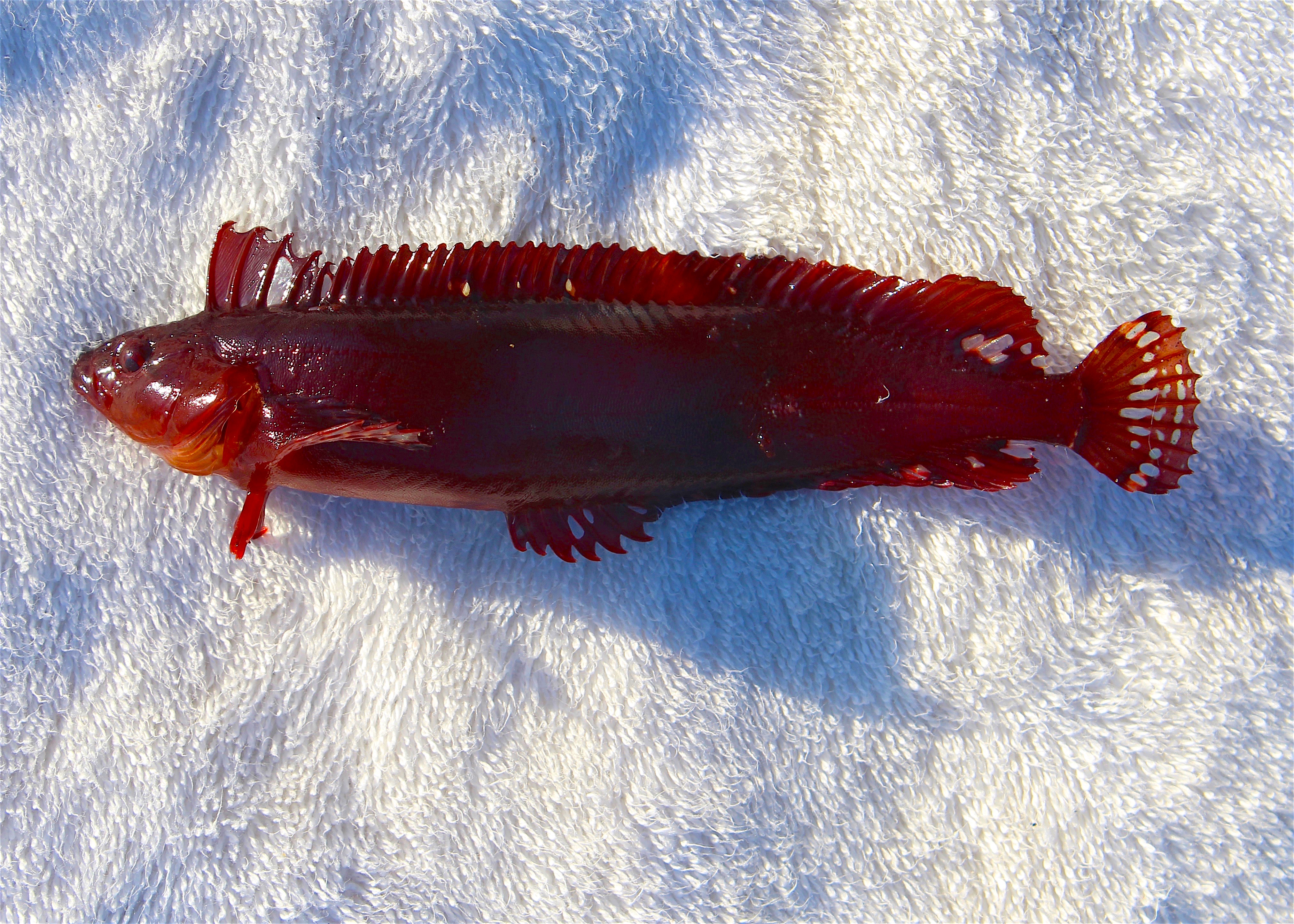
Crevice Kelpfish
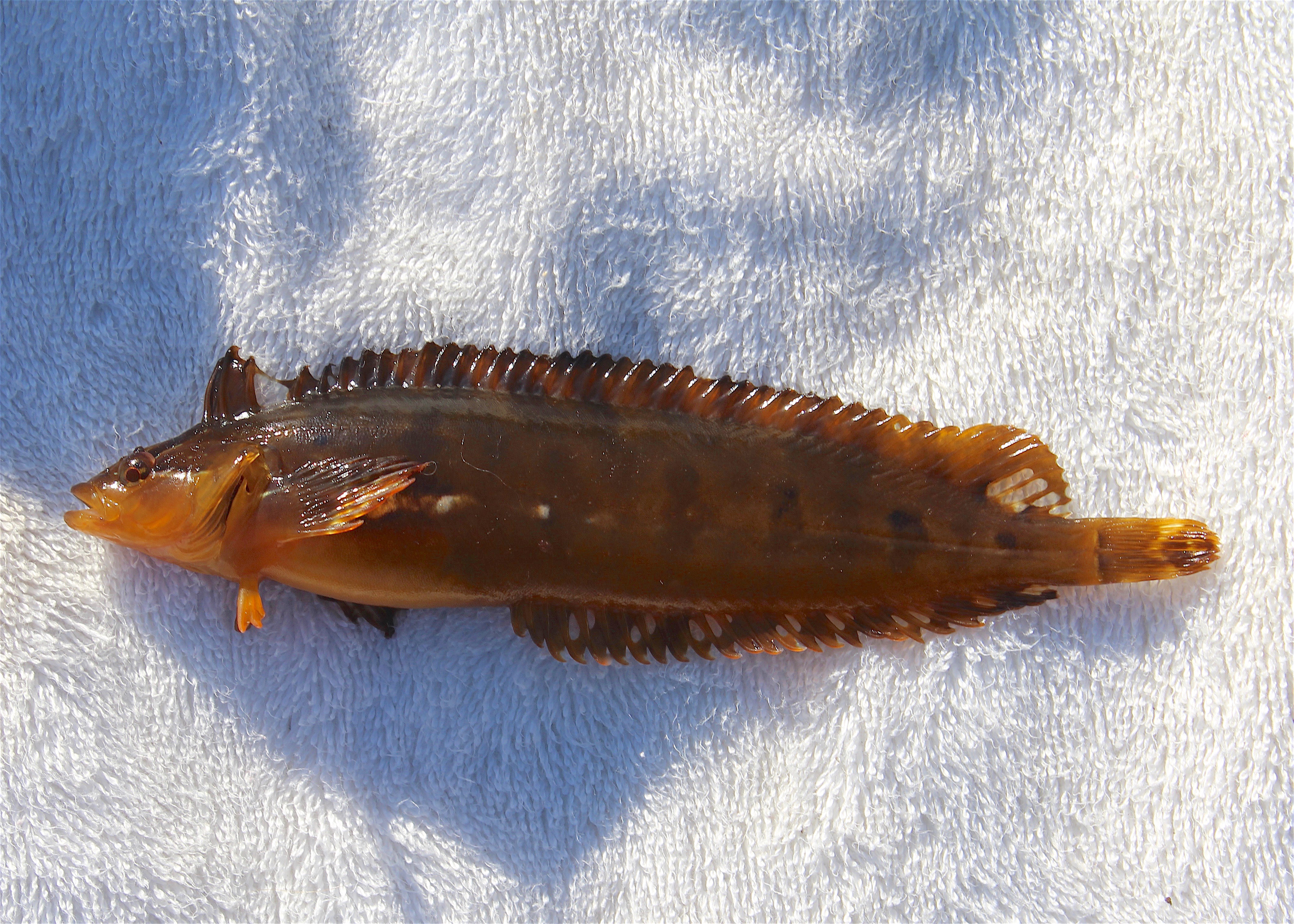
Giant Kelpfish
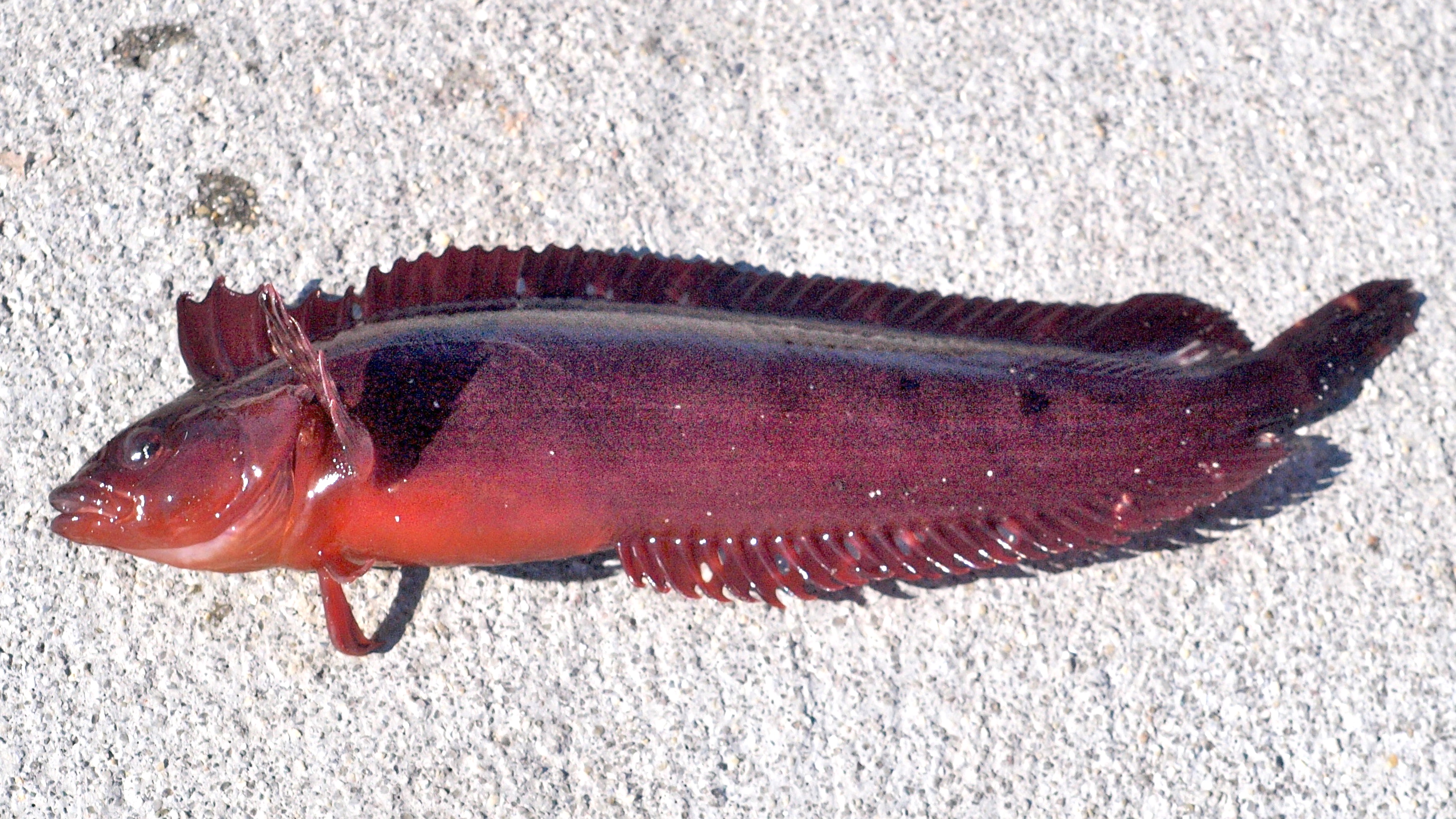
A colorful kelpfish
<*}}}}}}}}}>< — Another species is noted in The ragfish, Icosteus aenigmaticus Lockington, 1880: a synthesis of historical and recent records from the North Pacific Ocean and the Bering Sea. From: Marine Fisheries Review, George H. Allen, 9/22/2003.
“Hook-and-line gear used by anglers have regularly sampled ragfish from shallow waters along the west coast of North America. An adult taken from a breakwater at Monterey Bay, Calif., was previously mentioned (Bolin, 1940).”
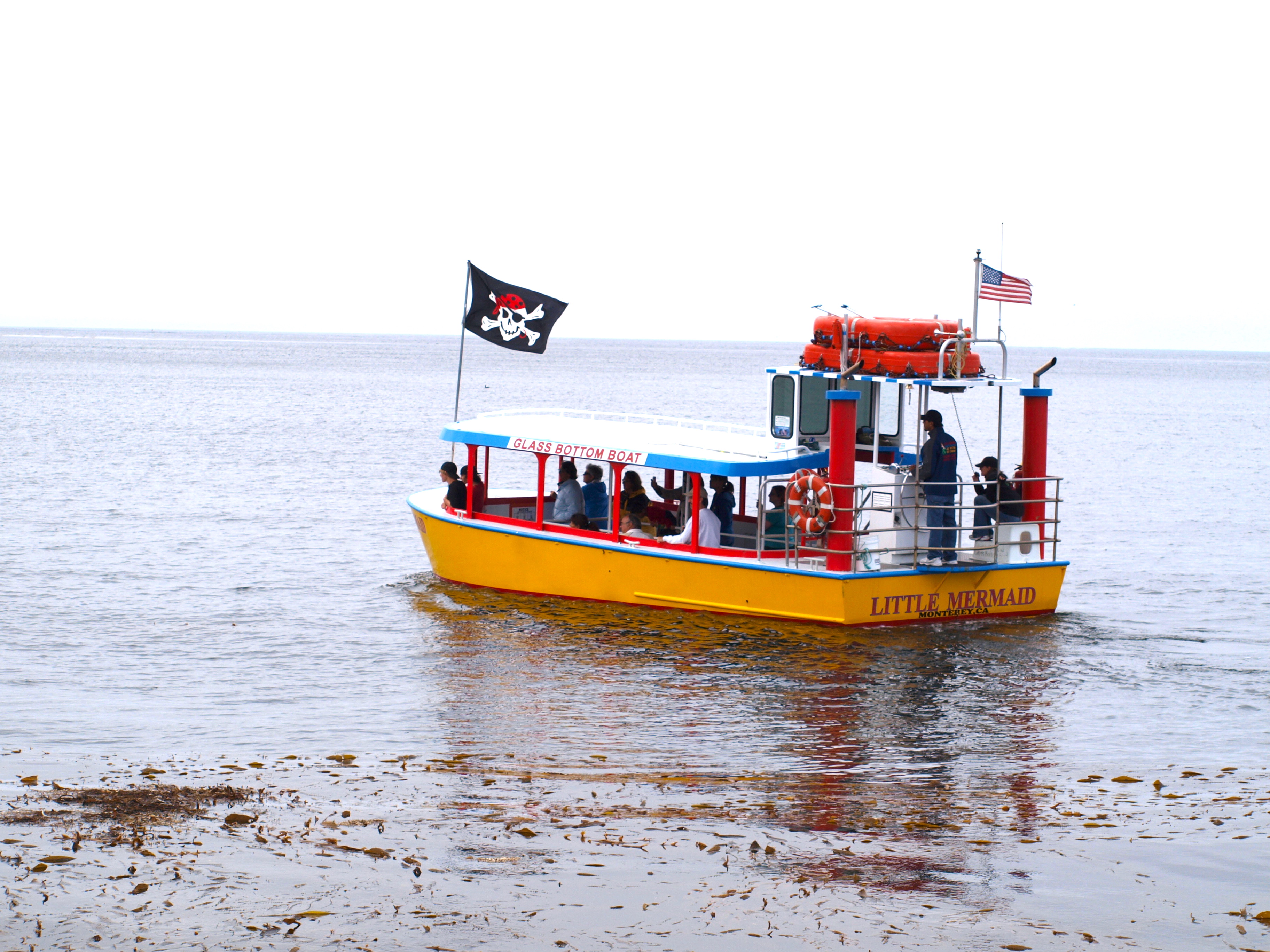
<*}}}}}}}}}>< — Affirming the good variety of fish taken at the pier by anglers are the angler surveys done by Pacific States Marine Fisheries Commission. The 2004-2009 surveys showed 21 different species. Black and yellow rockfish, blackperch and striped seaperch showed up five out of the six years, blue rockfish, kelp rockfish and rubberlip seaperch four out of the years. Numerically, striped seaperch led the list followed by blackperch, blue rockfish, black and yellow rockfish, and kelp rockfish.
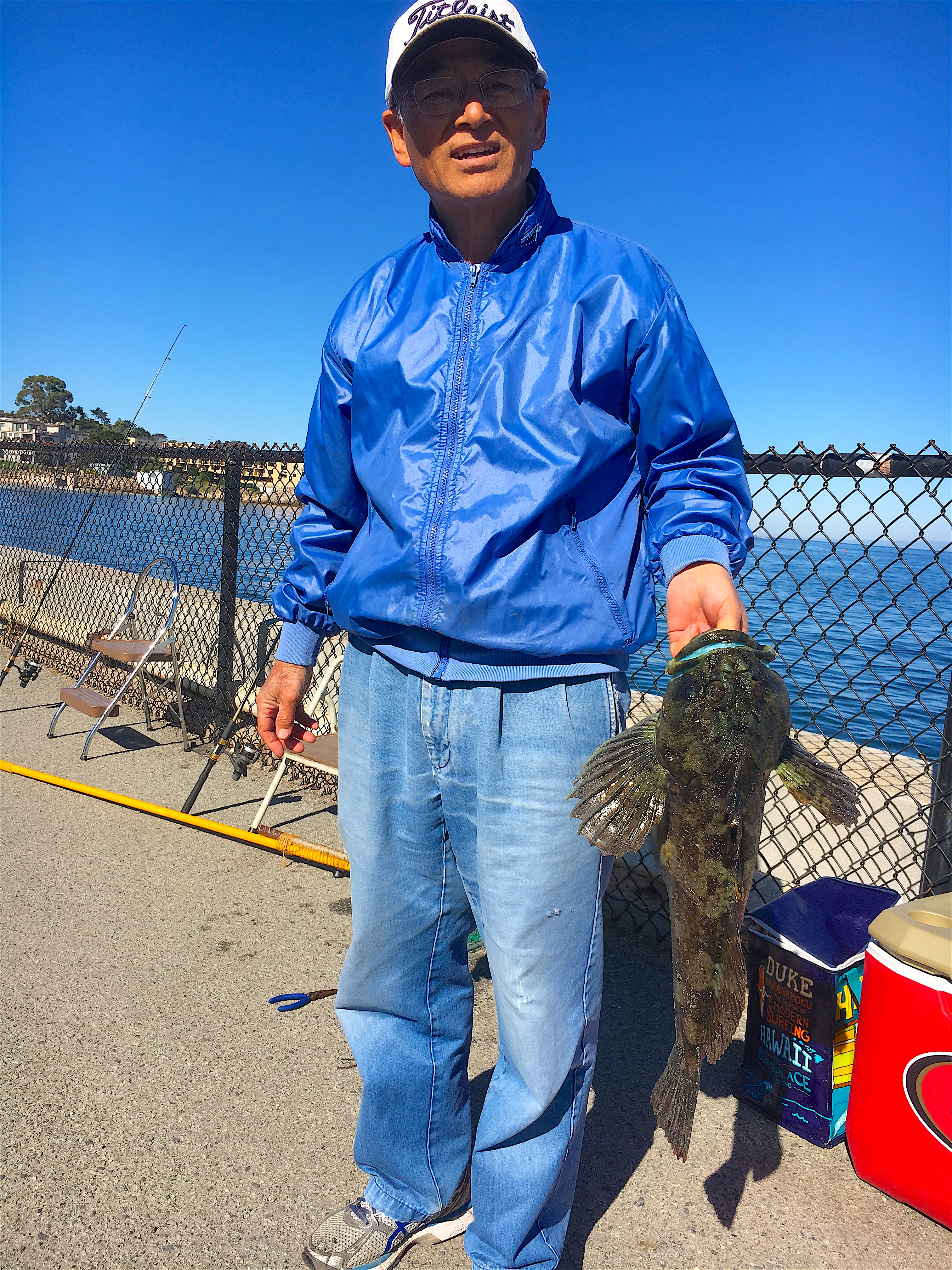
Cabezon caught by Ted Harada
<*}}}}}}}}}>< — Perhaps in part to recognize the rich and diverse number of species found in these waters, the Monterey City Council in 1998 designated the waters stretching from the Coast Guard Pier to the Pacific Grove city limits (just past the Monterey Bay Aquarium) as the Ed Ricketts Underwater Park. Ricketts was one of the West’s most famous marine biologists, author of what still may be the best book of inshore creatures—“Between Pacific Tides” (it’s called the “shoreline Bible” by some), and was the inspiration for Steinbeck’s “Doc” in the 1945 book Cannery Row. It’s seems a fitting tribute.
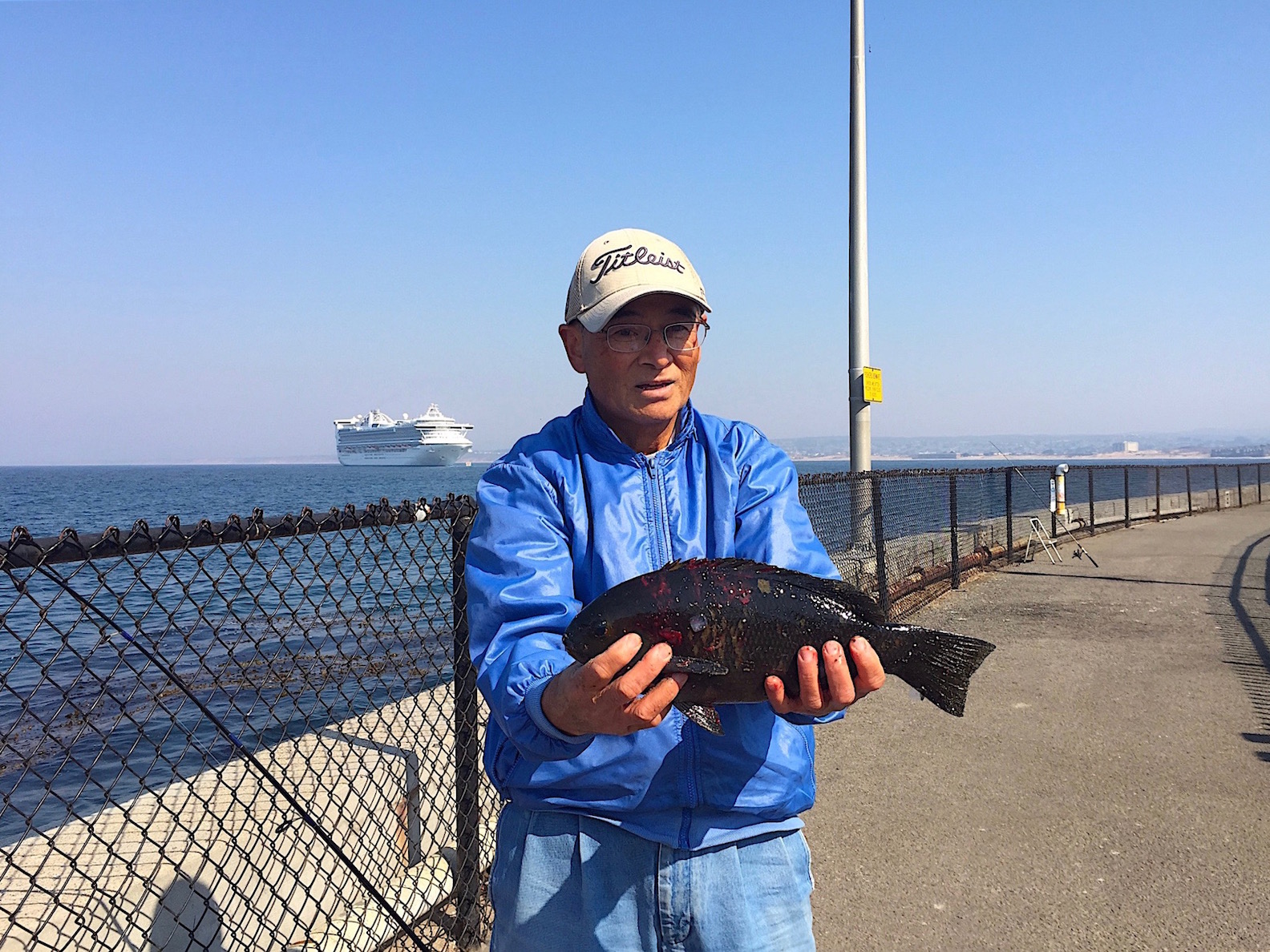
Ted Harada and what appears to be an opaleye
<*}}}}}}}}}>< — Just up the road from the pier sits the world famous Monterey Aquarium. It’s expensive and often way too crowded but also worth a visit, especially if you haven’t been there before or if you have some children with you. For more information: http://www.montereybayaquarium.org
<*}}}}}}}}}>< — In case you think I exaggerate when it comes to the sea lions.
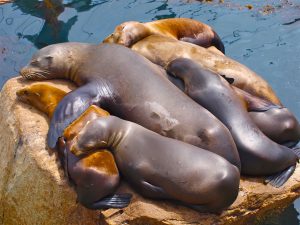
“The Trouble with Tribbles” is Nothing Compared to… The Problem With Pinnipeds
Any Star Trek fan can tell you that the trouble with tribbles is that they’re wonderfully adorable but multiply dangerously fast. But the fictional trouble with tribbles is nothing compared to the very real life problem with pinnipeds — those cute creatures we all love to watch cavort, sea lions and seals.
The pinniped population explosion has reached such unprecedented levels that they now threaten endangered fish runs. The critters have driven one major environmental law, the Marine Mammal Protection Act into a collision course with another, the Endangered species Act… nowhere is the problem so acute as in California where the lusty lions have increased their numbers to a whopping 180,000. Ironically, those huge numbers of sea lions enjoy more protection under the law than California’s 5,000 mountain lions.
Sea lions sometimes even choose their favorite fishing boats, following them faithfully all the way out and back Protected by the National Marine Fisheries Service (NMFS) under the Marine Mammal Protection Act, the sea lions have boldly gone where no pinnipeds have dared to go before. They have left the coast to move upriver in pursuit of anglers’ catches, invaded wharves to the point of sinking boats in marinas, and even moved on to the rescue vessels of the Coast Guard forcing the Coast Guardsmen to resort to high pressure hoses to get their boats back…
From selling sea lion food to tourists at the Monterey Wharf, the town moved to prohibit feeding the animals even before NMFS made it law. That move came after the sea lions began sinking boats at their moorings. At some wharves signs have been posted warning tourists about aggressive individual sea lions. Even a Coast Guard captain was attacked during a recent invasion of the Coast Guard docks.
—Andrea Granahan, Albion Monitor /News, April 3, 1997
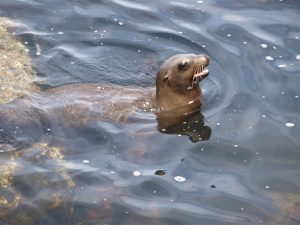
800 Sea Lions Roar Into Monterey Bay
An unusual invasion of young male sea lions took over the Monterey Coast Guard station during the past week, causing more chaos on the waterfront than frat boys on spring break.
“They’re like locusts,” said Coast Guard Lieutenant Commander Dean Lee. “We’ve been overrun.” Lee said as many as 800 of the blubbery beasts have converged near the Monterey Coast Guard station since Memorial Day, lounging on walkways and small boats, scampering across parking lots and enchanting tourists with their whimsical antics. Monterey is a preferred stopping-off spot for sea lions, but no one knows why this year’s crowd is so much larger than usual. “Honestly, there are just tons of them,” said Christina Little, office manager for Bradley’s Harbor-Front Restaurant, where patrons have been enjoying an unrivaled nature show. “They’re just swimming and snuggling and lying all over the place.”
Despite their 200- to 300-pound bulk, the sea lions are amazingly agile, Lee said. “They can scale steep rocks and jump onto almost any boat. They’ve come right over the seawall and onto the pavement. And they don’t even have feet like we think of them, they just scootch along like enormous inchworms.” But the whiskery pinnipeds have a decidedly dangerous side. Belligerent lions have bitten one unwary woman, challenged boat owners and nearly capsized two boats by piling on for a group snooze. The racket from their barking is deafening, and they’ve befouled beaches, boats and walkways with vast amounts of fishy excrement. The bitten women was a tourist who tried to pet a sea lion. “People look at those big Bambi eyes, and they don’t notice the big, sharp teeth,” SPCA spokeswoman Maia Carroll said.
Carroll said the young male sea lions now carpeting the shores of the Monterey harbor would normally be “cruising the California coast, looking for a place to set up shop.” A similar invasion took place four years ago and lasted for four weeks, until the food supply was used up, Carroll said. SPCA workers rescued 160 sick and starving young sea lions during that period, she said.
Coast Guard officials fought back yesterday with high-pressure hoses and brooms. The idea, approved by local humane society officers, is to interrupt the lions’ naps so persistently that they decide to haul out somewhere else. The battle for control of the pier has drawn a lot of spectators and should continue through the weekend. If the hoses and brooms don’t work, the Coast Guard may resort to seal bombs—explosives intended to scare away, not blow up, the annoying creatures. “This weekend should be a peak time if people want to come down and see massive amounts of sea lions,” Lee said. “But we are warning people to keep a safe distance—these guys bite.”
—Maria Alicia Gaura, San Francisco Chronicle, June 1, 1996
<*}}}}}}}}}>< — And then there are the cormorants.
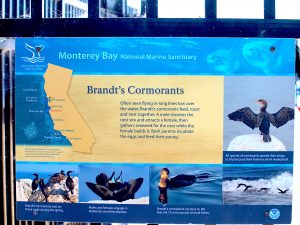
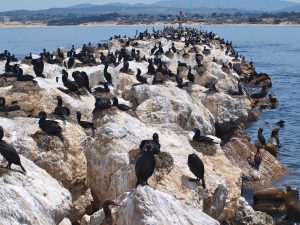
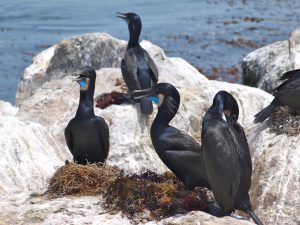
History Note. Although most people never realize it, the Coast Guard Pier is a reincarnation of types for a pier that set on this same site for two decades. That pier was the Coalinga Oil and Transportation Pier built in 1904. Also known as the Associated Oil Company Pier, the 650-foot pier was destroyed by the Associated Oil Company fire of 1924. That fire destroyed several canneries on Cannery Row, threatened to spread fire throughout the town of Monterey, and left blackened-pilings in its wake.
Unknown Number Dead; Buried in Blast Ruins — Flaming Oil on Bay Waters Threatening Local Waterfront
The Monterey Municipal wharf and Booth’s Cannery appeared as though they were doomed to destruction by fire this afternoon when thousands of gallons of flaming oil moved across the surface of the bay from a 55,000 barrel tank of oil and came within 300 feet of those structures. Fortunately the fire burned itself out before reaching the wooden building and wharf.
Plans were being made today to search for dead among the ruins of the fire-stricken Associated and Standard Oil Companies yard in New Monterey as soon as the great masses of steel wreckage had sufficiently cooled…
The fire this afternoon was confined to one 55,000 barrel tank of heavy crude oil. This tank is located near the water’s edge and is burning slowly. At 3:50 o’clock P.M. a great cloud of smoke and flame was seen to arise from the last burning oil tank. It was the sign that this tank had spilled its contents onto the ground, thus probably marking the end of the dreaded holocaust…
The latest check on dead and injured gives the following: THE DEAD, Private Geo. Boleo, Headquarters company 11th Cavalry. From Spencer, Mass. Private Eustace Watkins, Battery E, 76th Field Artillery. From Burlington, Vt. Other dead are said to be in the ruins. Many reports have it that men, women and children were seen to perish in the ruins. These reports can only be verified or definitely denied after a thorough search of the ruins…
The fire started at 10:30 a.m. yesterday morning after a volt of lightning during a freak storm had struck the top of an Associated Oil storage tank. The storm had played over Monterey for twenty minutes bringing with it hail, rain, thunder and lightning. The lightning struck first a tree on the Presidio grounds, splitting the tree and throwing to the ground a soldier standing in the vicinity; the next bolt struck a dwelling in Chinatown, with no more damage than frightening the inhabitants. The third bolt flashed to the top of the oil tank and, according to witnesses, caused the oil paper roofing of the tank to immediately become a mass of flames. In the wink of the eye the entire top of the tank blared forth into flame and sent forth huge clouds of hideous black smoke. Great billows of the smoke rolled heaven-ward giving the first warning that an oil fire raged within the city limits.
Fire alarms brought to the scene the Monterey, New Monterey, Oak Grove, Carmel, and Pacific Grove fire departments… Slowly and with terrific heat the oil fire burned down into the tank. Slowly the paint on the outside of the tank could be seen peeling away from the top, marking the point at which the flaming oil level stood…
Across the Southern Pacific tracks stood a gasoline storage tank, containing about 15,000 barrels of the highly explosive fluid. This tank was surrounded by a concrete wall thirty feet in height and ten feet thick. Inside this wall at the top stood water eight inches deep and was considered simple protection for the gasoline stored within… Between the railroad tracks and the bay front was situated the tank of the Standard Oil company, consisting of three tanks of gasoline, one of distillate, one of kerosene and the pumping plant. Thus was the setting of the place destined to become a seething furnace of flames.
—Peninsula Daily Herald. September 15, 1924
What little was left of the Associated Oil Company Pier after the fire would soon be gone. And then, just five years later in 1929, Congress appropriated funds for the construction of a breakwater at Monterey. The breakwater and its 400-foot extension would be built over the site (and assumed remaining pilings) of the Associated Oil Company Pier. The breakwater was completed in1934. Today most people simply call the breakwater the Coast Guard Pier or the Breakwater.
The 30s saw the expansion and growth of the sardine industry that helped make the area famous. “The Street of the Sardine” began at the breakwater (and today’s beach) with the San Carlos and E.B. Gross canneries.
Not much has changed to the original breakwater although a new boat launch was added during the pier’s closure from September 11, 2001 to October 13, 2004 (closed for security purposes following the terrorist attack of 9/11/01).
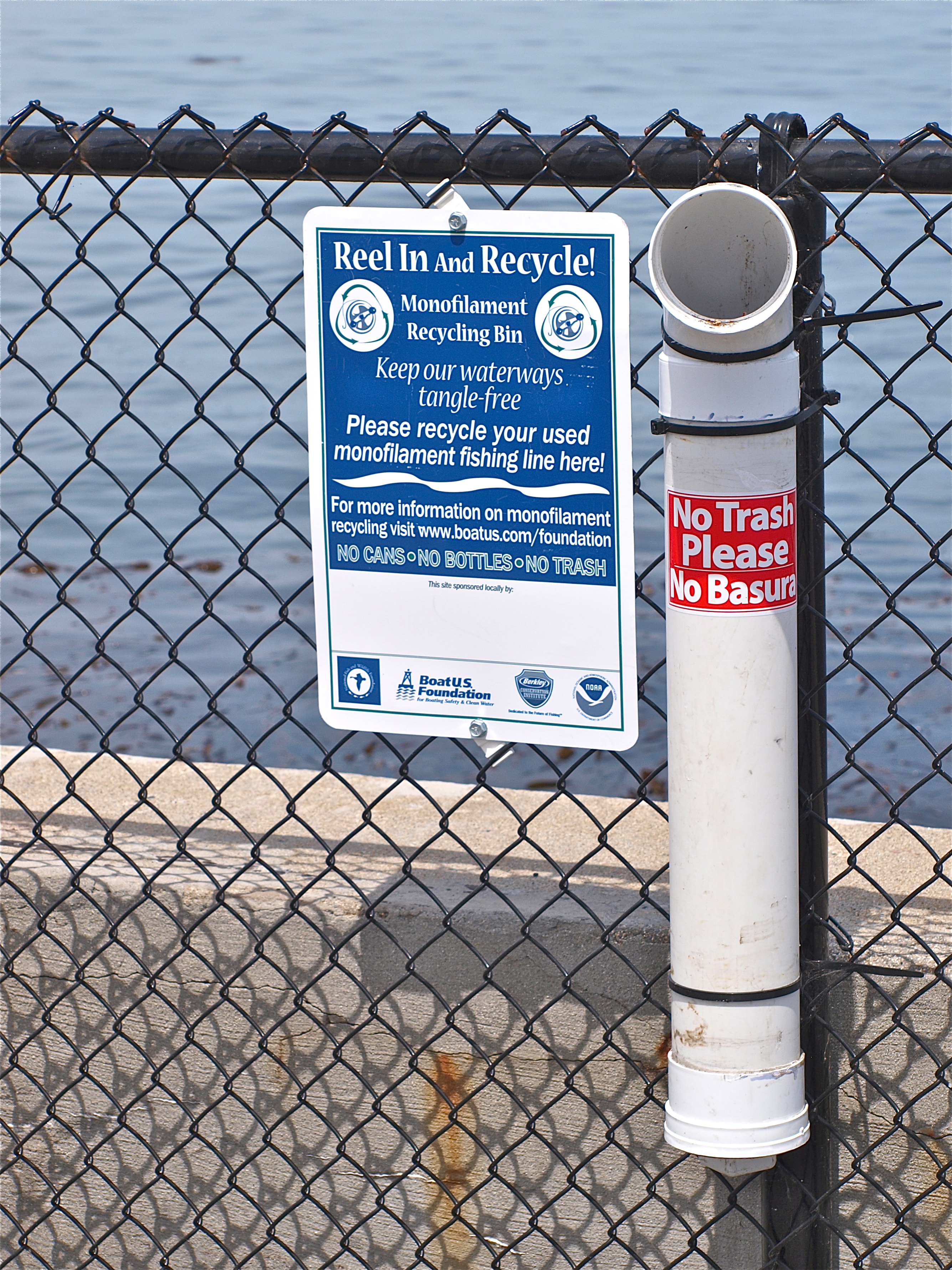
Monterey Coast Guard Pier Facts
Hours: Open sunrise to sunset.
Facilities: There is a public restroom in the parking lot at the foot of the pier. Metered parking is available in the parking lot (that takes credit cards) although spaces can fill early (and make sure you feed the meters after 9 AM or the “meter maids” will leave you an unwelcome gift on your windshield. There are grass lawns and picnic tables adjacent to the beach. There’s a deli at the end of parking lot. Snacks or a more substantial breakfast or lunch are available.
Handicapped Facilities: The walkway is suitable for a wheelchair although it would be hard to bring a fish over the wall in front of the rocks.
Location: 36363147″ N 121533561″ W
How To Get There: From Hwy 1 going north: Take the Aguajito Road exit, turn left at the first traffic signal intersection, which is Aguajito Road, and continue under Highway 1 and cross Fremont Street. At the next traffic signal intersection, which is Del Monte Avenue, turn left. Continue down Del Monte Avenue and under the tunnel where the street turns into Lighthouse Avenue. Get into the right-hand lane. As the street veers to the right it turns into Foam Street. Continue on Foam Street to the first right and turn into the parking lot. From Hwy 1 going south: Take the Del Monte Avenue exit, continue down Del Monte Avenue for several blocks and go under the tunnel where the street turns into Lighthouse Avenue. Get into the right-hand lane. As the street veers to the right it turns into Foam Street. Continue on Foam Street to the first right and turn into the parking lot.
Management: City of Monterey.
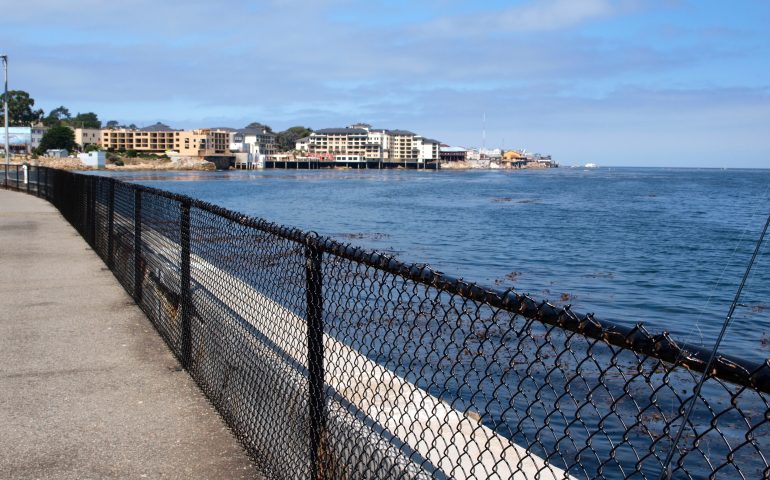
TO KEN JONES AND KEN HIRATA,
Thanks so much for the great pictures. I live north of Seattle and have always preferred pier and jetty fishing.
We plan to be in Pacific Grove this year and I hope to run into Ken Hirata while there’
I started pier fishing in Oceanside, Calif. around 1948 and I got hooked.
Doug Smith
Anacortes, Wa
Hello everyone, I have finally found a very high quality and time interrupted service where I was able to buy 600 sq ft modular homes for sale. Therefore, if you also want to buy a modular house of good size, then I advise you this site and its service, because it is really very high quality and very efficient for this! Good luck and goodbye.
Being a stay-at-home parent, I needed a fun activity during my downtime. I was looking for something engaging and entertaining. I found andar-bahars.in , which introduced me to Dafabet’s Andar Bahar offerings. The site provides comprehensive information about Dafabet’s platform, including bonuses and promotions tailored for Indian players. The enjoyable gameplay and attractive bonuses have become a delightful part of my downtime.
Drive Mad is a perfect blend of skill and chaos! The vehicle mechanics are unpredictable in the best way possible, forcing me to constantly adjust my strategy.
Hi! I had been looking for professional assistance with my dissertation proposal when I saw a recommendation for this service on a research blog. It piqued my interest, so I decided to check out phdresearchproposal.org. They helped me shape my ideas into a focused and cohesive proposal. The experience was smooth and efficient. The writers provided insightful feedback, and my proposal turned out much better than I had anticipated. I was pleased with the results and relieved to meet my deadline.